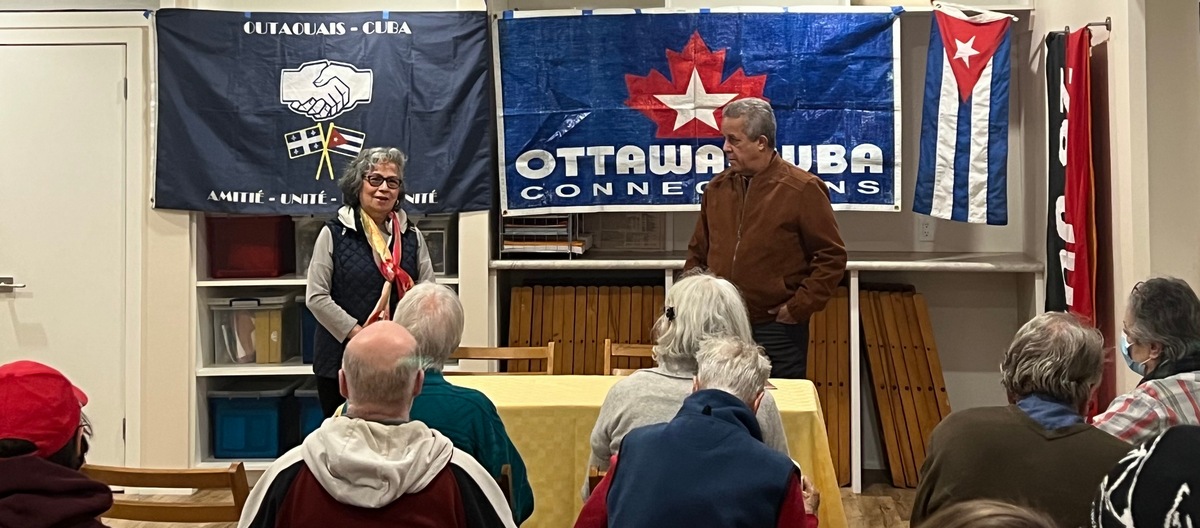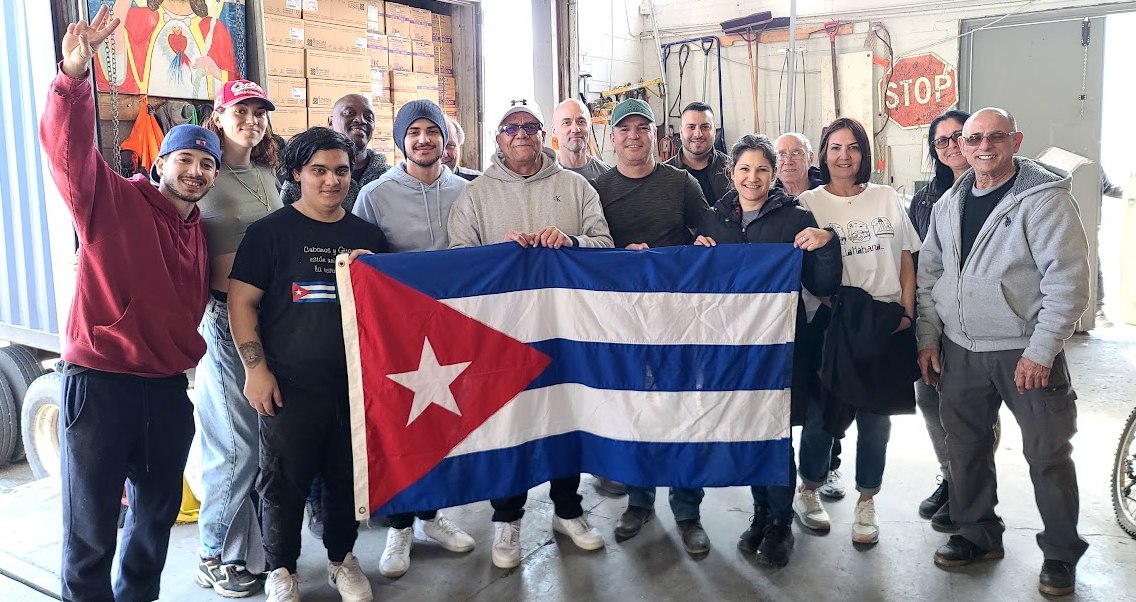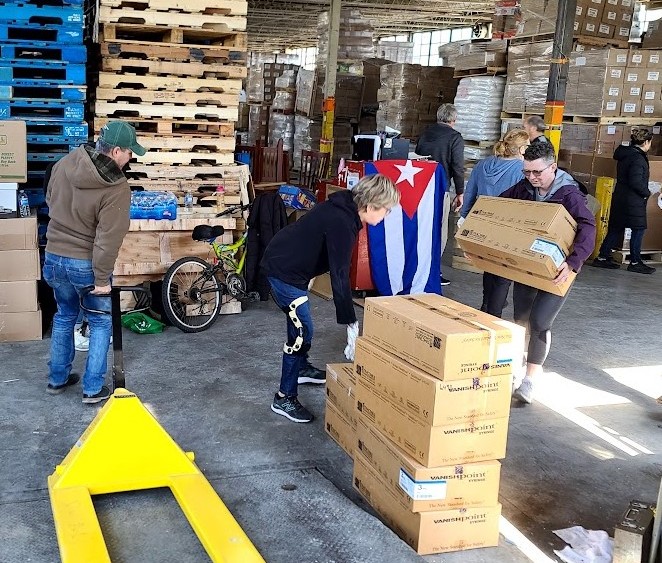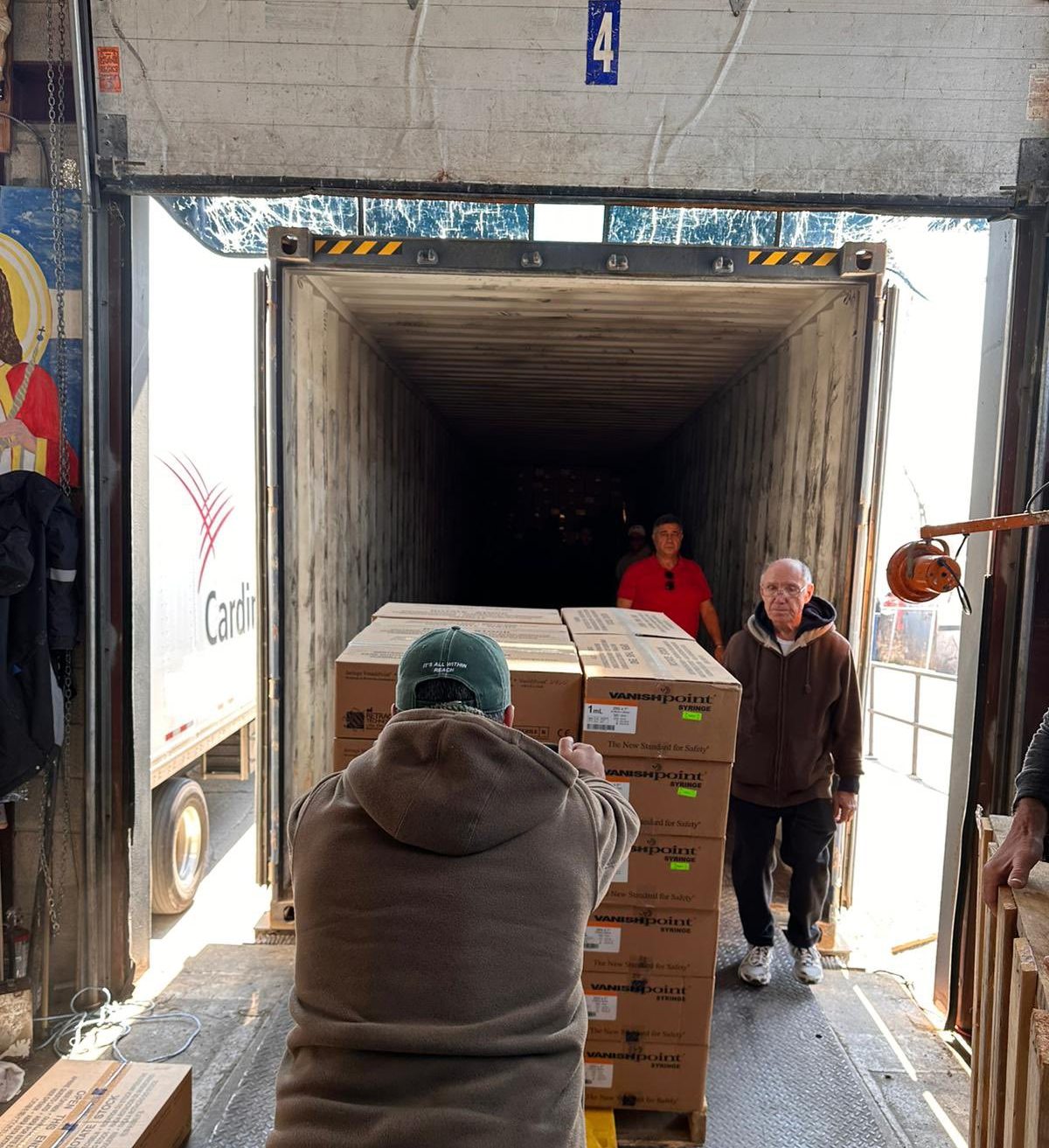No. 4
April 2023
Earth Day 2023
• All Out to Humanize the Natural and Social Environment!
Further Integration of Canada's Energy Resources with U.S. War Economy
• Policy of Exporting Electricity to the U.S.
• Hydro-Québec's "Shared Ownership" of Power Lines with Blackstone Hedge Fund
Problems with "Green Energy" Projects
• Massive New
Subsidy for Volkswagen Battery Facility to
Be Built in St. Thomas, Ontario
• GM Announcement on Electric Drive Production in St. Catharines
• Largest
Battery Storage Project in Canada on Haudenosaunee Grand River
Territory
• Ontario
Government Increases Electricity Capacity
for Electrical Battery Production
• Fraud in Managing Ontario's Electrical System
• Information on Electrical Production in Ontario
• Video: Discussion on Ontario's Energy System
NATO
• NATO's Drive to Reinvent Itself
• Two-Day Conference of National Armaments Directors
• Meeting of U.S.-Led Ukraine Defense Contact Group
25th Anniversary of the Good Friday Agreement
• British
Government's Attempts to Block People of Ireland
from Exercising Their Sovereignty
Cuba
• Cuban People Give Strong Vote of Confidence to Their Revolution
• Lively Discussion on Elections in Cuba
• Some Distinguishing Features of Cuba's Electoral System
• Ninth Container of Medical Aid Sent to Cuba by Cuban Canadians
India
• Farmers and
Workers Remain Undeterred
Despite Show of Force
Earth Day 2023
All Out to Humanize the Natural
and
Social Environment!

Party contingent at Montreal Earth Day rally, April 22, 2023.
On the occasion of Earth Day 2023, the Communist Party of Canada (Marxist-Leninist) salutes the youth and working people of this country and the peoples all over the world who are organizing to restrict and deprive the monopolies and oligopolies and governments in their service of their ability to pollute, destroy, wage wars, exploit, criminalize and deprive the people of their right to a say over all matters which affect their lives. They trample the sovereign rights of all countries, engage in nation-wrecking and activities which destroy the social and natural environment and also deprive the Indigenous Peoples of treaty and hereditary rights.
CPC(M-L) recognizes the gravity of the situation facing humankind as a result of the climate crisis. Canadians, Quebeckers and the Indigenous Peoples are held hostage by a cartel party system which brings governments to power which serve narrow private interests and cause serious harm to the natural and social environment. Taking care of Mother Earth is a priority; opposing government pay-the-rich schemes is a necessity. It is the striving for empowerment of working people from all walks of life which is life-giving. The natural and social environment cannot be humanized without opposing the stranglehold of the oligopolies over government decision-making and their rule which is causing so much harm around the world.
CPC(M-L) denounces the ruling elite for marketing self-serving plans in the name of "greening the economy. The party also denounces attempts at dividing the people by presenting demands to preserve the natural environment as against job creation which pits one section of the people against another on the basis of which side they defend. It is a fact that technical and scientific innovations demand new infrastructures and processes of production. However, the schemes the government is financing are not discussed with the people and their aim is profits, not job creation. On the contrary, the new normal is to force the approval of projects before anything is known about them. Police powers are used to impose them in the name of national security, prosperity and meeting crucial goals to curb pollution and create jobs. The degradation of the land, water and sea levels continues as does the harm to flora and fauna and humankind.
Governments continue their relentless promotion and defence of companies whose pursuit of private profit endangers the workers and the public and dispossesses the Indigenous peoples while causing grave harm to Mother Earth. Despite lofty proclamations, they continue to expropriate Indigenous peoples, trample on their land and attempt to silence the thousands of Canadians and Quebeckers opposing specific projects such as the Trans Mountain Pipeline and the Coastal GasLink (CGL) pipeline construction, deforestation, deregulation of railways, new industrial battery storage projects and many others which will bring harm to the natural environment.
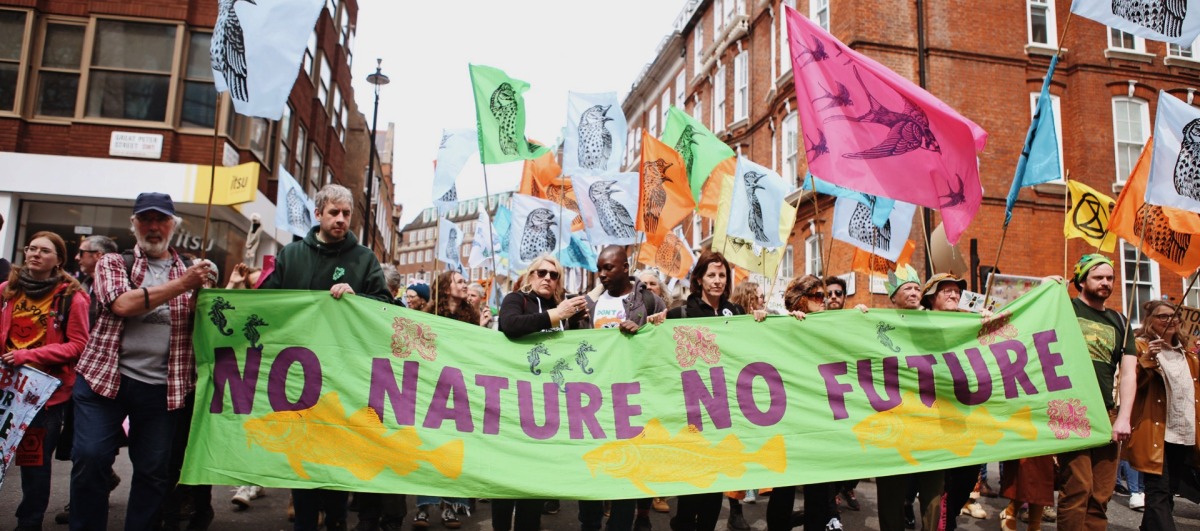

Earth Day demonstration of 60,000 in London, England, April 22,
2023.
As an example of the serious concerns which are emerging following 20 years of hype for pay-the-rich schemes for the construction and use of industrial wind-farms as a form of "green energy" and "job creation," the experience of those living near these industrial projects show significant negative consequences. These projects generate acoustic waves and vibrations in the infrasound range. Effects such as emotional/psychological disorders and sleep disturbances/failures, headaches, fatigue, decreased concentration and impact on quality of life are caused by local presence of wind energy facilities. There is also evidence emerging of contamination of water wells following the construction of industrial wind turbines. Besides the construction of access roads, underground trenches for wires and foundations, a matter of concern with their construction is the use of pile driving, where rods are slammed into the ground to great depths over long periods of time causing vibration and dislodging material. Over time this can cause harm to underground water sources. This includes by blocking the flow of water which existed previously while in some places water quality has revealed discolouration, odour, taste and sediment issues as well as "contaminants of concern" identified by sampling, including lead, arsenic and total coliform levels.
The creation of alternative forms of energy which do not involve fossil fuels are necessary but are themselves often very polluting. Such things can be brought under control but the support for the approach of making a quick buck on the latest invention or acquiring government subsidies in the billions of dollars is opportunist and harmful. New technologies are here to stay. How they are used and for what purpose is a matter which must be brought under the control of the people, not benefit narrow private interests which have taken over government decision-making.
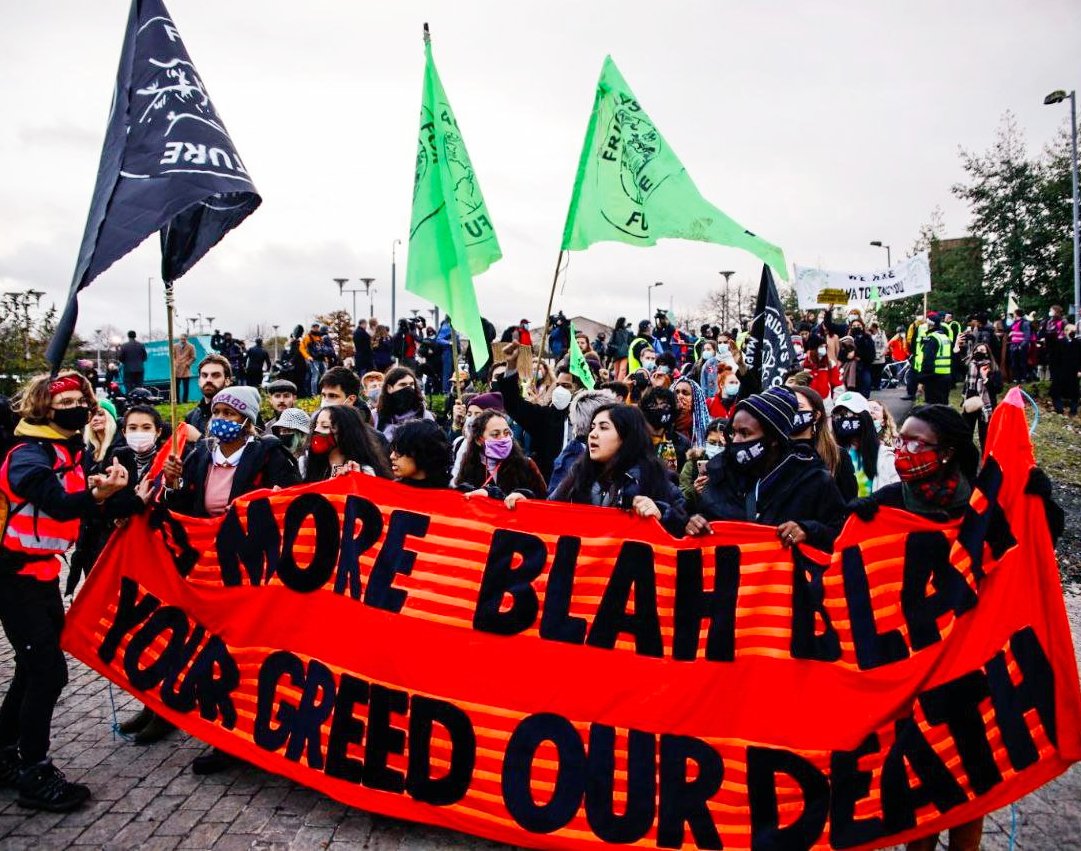 On Earth Day April 22, the
peoples of the world come together to demand proper attention be
paid to Mother Earth and denounce the reality that their
concerns are not being met. The more environmental disasters
occur, the more disinformation pours from the official circles
in the United States, Britain, Canada, the European countries
and others which represent the global elite. They attempt to
give the impression they are taking measures to bring the
climate crisis under control while in fact increasing the number
of damaging pay-the-rich schemes and other self-serving
practices, all the while spouting the high ideal of "greening
the economy."
On Earth Day April 22, the
peoples of the world come together to demand proper attention be
paid to Mother Earth and denounce the reality that their
concerns are not being met. The more environmental disasters
occur, the more disinformation pours from the official circles
in the United States, Britain, Canada, the European countries
and others which represent the global elite. They attempt to
give the impression they are taking measures to bring the
climate crisis under control while in fact increasing the number
of damaging pay-the-rich schemes and other self-serving
practices, all the while spouting the high ideal of "greening
the economy."
People are striving to stay the hand of the elites and hold them to account to overcome the disasters taking place as a result of the climate crisis and related problems. Pernicious practices of the ruling elite such as fracking, clear cutting, detrimental mining methods, contamination of rivers, lakes and oceans, the privatization of water, fraudulent environmental assessments or their complete elimination to "fast-track" projects and dispossession of the rightful holders and stewards of the land and wars of aggression and occupations must end!
On Earth Day Uphold the Dignity of Labour!
On Earth Day it is important to uphold the dignity of labour. Mother Earth and the work of working people transforming its bounty into means to live and thrive as human beings are the two pillars of all social wealth. Modern society cannot be built without consciously upholding the dignity of labour as well as protecting Mother Earth. The two go hand-in-hand as it is empowered working people who have an interest and are capable defenders of the earth. It is by affirming the rights of working people and Indigenous Peoples while protecting Mother Earth that society can progress in the 21st century on a modern basis.
Everything regarding the socialized economy must become public and exposed for all to see and evaluate. No oligarch or official can be allowed to hide behind a curtain of government enforced private control. The modern economy encompasses all peoples and Mother Earth as one sheet of steel and is everybody's business regardless of position. To achieve this, working people must persist in stating their concerns and demands as a first step to establishing a real hold on political and economic power. In this way they can bring to the fore the human factor/social consciousness and lead the movement to humanize the social and natural environment.
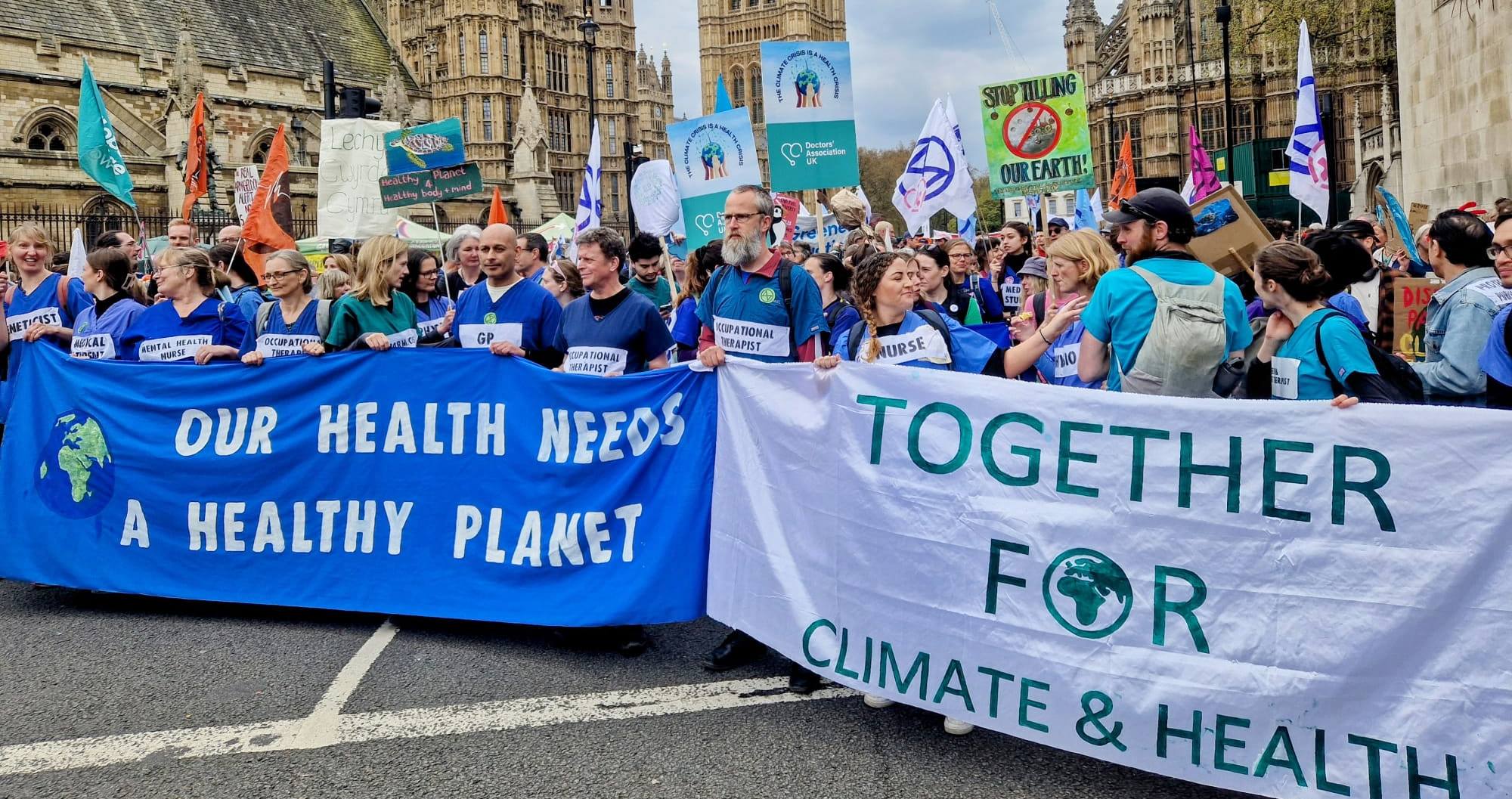 Health
care workers' contingent in Earth Day demonstration, London,
England, April 22, 2023.
Health
care workers' contingent in Earth Day demonstration, London,
England, April 22, 2023.
To uphold the dignity of labour and Mother Earth means to bring social consciousness to the fore within the socialized economy and in political affairs. Activating the human factor/social consciousness to negate the anti-human factor/anti-consciousness is the order of the day. Only if working people themselves have a say and control over the production and distribution of the social product they create through their work can the serious problems facing Mother Earth and our societies be provided with solutions.
The economy and people can only thrive when the interests of Mother Earth and the rights of all are defended and neo-colonial and imperialist practices are ended. There is no Great Wall between developing the economy, ensuring a livelihood for all and humanizing the natural environment. On the contrary, without activating the human factor/social consciousness and ending the exploitation of persons by persons, humanizing the natural and social environment will not succeed.
On Earth Day Uphold the Hereditary Sovereign Rights of Indigenous Peoples!
The Indigenous Peoples are the stewards and protectors of Turtle Island and holders of hereditary sovereign rights. These rights cannot be over-ridden by what are called partnership agreements which maintain that "the Crown" has the final say in matters of concern. The Indigenous Peoples have never relinquished their sovereign rights. They are hereditary. They cannot be given, taken away or forfeited in any way no matter what deals are struck. Governments in Canada are obligated to engage with them on a nation-to-nation basis.
The Indigenous Peoples continue to bravely defend themselves and Mother Earth from the indignities of neo-colonial pillage and ruin. They and their allies demand a full stop to the practices which use the power of the state and force to expropriate them. They demand reparations for the damages they have suffered. A modern Canadian economy can only thrive within this overall recognition and perspective.
On Earth Day let everyone demand that governments enter into new arrangements that honour the Indigenous Peoples' sovereign rights to their ancestral lands.
On Earth Day Demand an End to War Production and
the Pentagon's War Machine!
 A significant and necessary act
on Earth Day is to denounce the U.S. Pentagon as the biggest
polluter in the world. U.S./NATO-led wars of aggression and
occupation and the U.S. war industry are based on the
destruction of the productive forces and Mother Earth in order
to dominate rivals. Earth Day can only be true to itself if it
denounces the wastefulness and parasitism of the war industry.
Canada pays billions for armaments for the U.S. proxy war in
Ukraine but then says that paying public servants according to
their conditions means that it will not be able to pay for the
delivery of public services, for social programs, housing for
all or even adequate shelters for abused women. It is fraud in
order to hide that imperialist war goes hand-in-hand with
attacks on the working people and destruction of the
environment.
A significant and necessary act
on Earth Day is to denounce the U.S. Pentagon as the biggest
polluter in the world. U.S./NATO-led wars of aggression and
occupation and the U.S. war industry are based on the
destruction of the productive forces and Mother Earth in order
to dominate rivals. Earth Day can only be true to itself if it
denounces the wastefulness and parasitism of the war industry.
Canada pays billions for armaments for the U.S. proxy war in
Ukraine but then says that paying public servants according to
their conditions means that it will not be able to pay for the
delivery of public services, for social programs, housing for
all or even adequate shelters for abused women. It is fraud in
order to hide that imperialist war goes hand-in-hand with
attacks on the working people and destruction of the
environment.
Dismantling the aggressive military alliance NATO and NORAD are required to stop the situation internationally whereby countries have to be on guard and devote their resources to war preparations, armaments and general defence, which in Canada's case are not for defence of Canada in the true sense but for threatening others. By dismantling NATO and NORAD and opposing the use of force and threats of force in international affairs, Canadians and Quebeckers can use resources so that humankind can flourish, rather than for the destruction of other peoples and societies which also destroys the natural environment.
Talk about "greening" the military with electrification or unmanned electric drones on land, sea and air, so that it can continue to dominate the world, albeit remotely or with less carbon emissions, must be rejected as a complete fraud and a grave danger to peace. Canada's participation in U.S. wars of aggression and regime change and the hypocrisy and fraud of NATO and UN missions carried out in the name of humanitarian aid, peace, freedom, democracy and discredited pretexts for war such as "responsibility to protect," "rules-based order" and "human rights" must all be opposed as threats to peace and the environment.
All governments of the ruling elite regardless of party affiliation, have shown in practice that they fully identify with the narrow stance of private interests of the rich and the demands of the war government in the United States and its understudy in Canada. To serve these private interests and in the same breath express concern for the environment is absurd.
 March in Washington, DC on Earth Day 2023
March in Washington, DC on Earth Day 2023
On Earth Day, Raise the Demand for the Renewal of the Political Process!
Concern for environmental degradation and ruination of Mother Earth must be consciously directed and broadened into a movement to empower the working people, to put them in the forefront of all economic, political and social decision-making. The people must put themselves in the position of decision-makers and take control of the direction of the economy so that it can be organized in a manner that protects the environment and affirms the right to be of the peoples of the entire world. This is the way forward to actually humanize the social and natural environment. It can be done! It must be Done!
All Out to Humanize the Natural and Social
Environment!
Further Integration of Canada's Energy Resources with U.S. War Economy
Policy of Exporting Electricity to the U.S.


Calgary action against War President Joe Biden's visit to
Canada, March 23, 2023.
The joint statement issued by Prime Minister Justin Trudeau and U.S. President Joe Biden during his visit to Ottawa on March 23-24 announced the launch of a one-year "Energy Transformation Task Force." The statement informs that the task force, amongst other things, is to "accelerate cooperation on critical clean energy opportunities and supply chains," to secure and strengthen "grid integration and resilience," and "develop cross-border alternative fuel corridors." Under the heading, "Invest in Our Collective Defense and Security," they state that they "will focus on two key sectors – pipelines and electricity – due to their criticality to our economies and their cross border nature."
What they mean by "our collective defense and security" is in fact a thinly veiled declaration that U.S. forces henceforth have a green light to enter Canada unimpeded. Indeed, the statement issued by Trudeau and Biden says: "Further, we reiterate that in each of our countries, should an adversary choose to target critical infrastructure systems, we will both respond."[1]
 Joe Biden's message to
Parliament, before the combined House and Senate, is most
clear: The United States wants Canada to continue to play its
full role in supplying the U.S. economy with raw materials
such as rare earths and minerals critical to the U.S. war
economy, and "clean" electrical power to transform them into
such items as semiconductors at IBM plants in the U.S. They
are then to be packaged at the IBM plant in Bromont, Quebec
which he said is "expanding with the support of the Canadian
government." A news release from the Prime Minister's office
that day said that Canada and the U.S. are each making
significant investments "creating good middle-class jobs for
workers on both sides of the border."
Joe Biden's message to
Parliament, before the combined House and Senate, is most
clear: The United States wants Canada to continue to play its
full role in supplying the U.S. economy with raw materials
such as rare earths and minerals critical to the U.S. war
economy, and "clean" electrical power to transform them into
such items as semiconductors at IBM plants in the U.S. They
are then to be packaged at the IBM plant in Bromont, Quebec
which he said is "expanding with the support of the Canadian
government." A news release from the Prime Minister's office
that day said that Canada and the U.S. are each making
significant investments "creating good middle-class jobs for
workers on both sides of the border."
This is also what was meant at the joint Trudeau-Biden press conference on March 24 when Biden said: "And by the way, we each have what the other needs. [...]The idea that somehow Canada is somehow put at a disadvantage – because we're going to probably be investing billions of dollars in their ability to package what is coming out of the semiconductor area – I don't get it. How's that in any way do anything other than hire and bring billions of dollars into Canada? [...] We greatly need Canada, in terms of the minerals that are needed. Well, you guys – we don't have the minerals to mine. You can mine them. You don't want to produce – I mean, you know, turn them into product. We do."
This is what IBM's Senior Vice President and Chief Research Officer was referring to when he spoke about "collaboration" that will "help strengthen [...] the global supply chain." Not a peep was heard from the subservient Canadian elite in response to the arrogance of declaring Canada a hewer of wood and drawer of water for the mighty U.S. empire.
Federal Government's Decision to Secure U.S. Supply of Electricity
In 2019, the Canadian Energy Regulator came into being through the adoption of the Canadian Energy Regulator Act, which replaced the National Energy Board (NEB) that had been set up 60 years earlier by the Diefenbaker government.
In the Speech from the Throne on September 27, 1962, the Diefenbaker government referred to the NEB, created in 1959, as being "responsible for regulating [...] international and interprovincial pipelines [...] international power lines, as well as Canadian imports and exports of energy." The NEB was important to the Diefenbaker government because it could encourage the signing of "large scale, long-term contracts for the export of power surplus to Canada's needs, present and potential" in order to "expedite the development of major power projects in Canada which are too large to be supported by the domestic market."[2]
Hydro-Québec, the major producer of hydro power in Canada, has a long history of building huge power dams such as the James Bay hydro project with the help of U.S. finance capital and exporting part of its electricity to the United States. This was the case when in 1962, Quebec's Lesage government nationalized most of the major private producers of hydro power which it was able to do it with the backing of Wall Street financiers.[3]
Like the NEB, the Canadian Energy Regulator's mandate is to "regulate companies that own and/or operate" 73,000 kilometres of "international or interprovincial pipelines," to "regulate power exports and the construction and operation [of 1,400 kilometres of] international and designated interprovincial power lines," as well as "and Canadian energy imports and exports."[4]
The following graphs show that Canada has always played a greater role in exporting electricity to the U.S. than in importing it, both in the most recent decade as well as over the last 30 years, as privatization and deregulation of North American power companies encouraged cross-border trade.
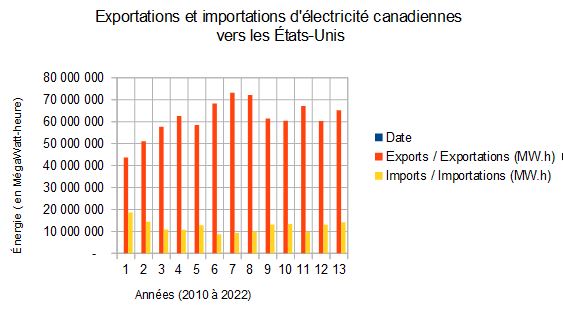 Canadian exports-imports of electricity to
the United States, 2010-2022.
Canadian exports-imports of electricity to
the United States, 2010-2022.
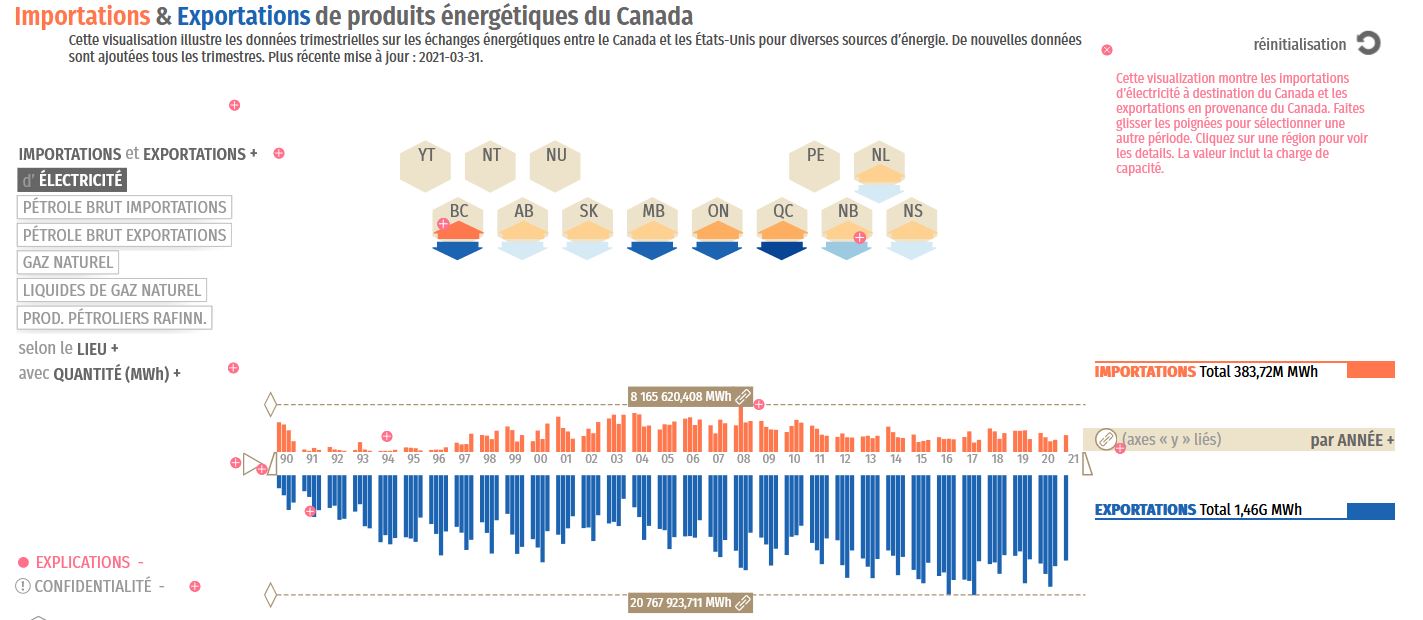 Canadian exports (blue) and imports
(orange) of electricity to the United States, 1991-2021,
showing on the top centre which provinces contribute.
Canadian exports (blue) and imports
(orange) of electricity to the United States, 1991-2021,
showing on the top centre which provinces contribute.
According to the Government of Canada website, the passage of the Canadian Energy Regulator Act had become necessary so as to help to "restore investor confidence, re-build public trust and advance Indigenous reconciliation" -- all "while ensuring good projects go ahead and our energy resources get to markets responsibly."
 This is the Trudeau
government's much touted "green shift," which is included in
Finance Minister and Deputy Prime Minister Chrystia Freeland's
"Made-in-Canada" 2023 budget. She likens the export of
Canada's vast natural resources, such as gas, oil and now
critical minerals -- so important to the U.S. war machine --
to a "new national project" similar to that, at the turn of
the 20th century, of the "new Transcontinental Railway" that
"connected Canada and the Canadian economy for the first
time."[5] In this "new national project" to
"build our generation's version of the Transcontinental
Railway, one that will protect our environment," she now
includes exporting "clean" electricity to the world.
This is the Trudeau
government's much touted "green shift," which is included in
Finance Minister and Deputy Prime Minister Chrystia Freeland's
"Made-in-Canada" 2023 budget. She likens the export of
Canada's vast natural resources, such as gas, oil and now
critical minerals -- so important to the U.S. war machine --
to a "new national project" similar to that, at the turn of
the 20th century, of the "new Transcontinental Railway" that
"connected Canada and the Canadian economy for the first
time."[5] In this "new national project" to
"build our generation's version of the Transcontinental
Railway, one that will protect our environment," she now
includes exporting "clean" electricity to the world.
Like Diefenbaker's 1962 claim to be working for the establishment of "a national energy grid," Freeland is promoting the idea that the Canadian people will reap the benefits of this sell-off of natural resources to the United States."Clean energy" is a euphemism for dispossessing the Indigenous Peoples and using the public treasury to finance the infrastructure that the U.S. needs.
"Canada has the potential to become a clean electricity superpower with a cross-Canada electricity grid that is more sustainable, more secure, and more affordable," she says.[6]
In the tax measures the Trudeau government is putting in place to achieve this, there is "a 15 per cent refundable tax credit for eligible investments in:
"- Non-emitting electricity generation systems: wind, concentrated solar, solar photovoltaic, hydro (including large-scale), wave, tidal, nuclear (including large-scale and small modular reactors);
"- Abated natural gas-fired electricity generation (which would be subject to an emissions intensity threshold compatible with a net-zero grid by 2035);
"- Stationary electricity storage systems that do not use fossil fuels in operation, such as batteries, pumped hydroelectric storage, and compressed air storage; and,
"- Equipment for the transmission of electricity between provinces and territories."[7]
These measures are almost a
verbatim repeat of the pay-the-rich schemes set out in the
Canada Growth Fund (CGF) established last fall by the Trudeau
government. As K.C. Adams pointed out in a background article
titled "The Fall Economic Statement: Much Ado About Nothing":
"the CGF will use public funds to 'scale up' private companies
and 'capitalize on Canada's abundance of natural resources and
strengthen critical supply chains' to serve the U.S. war
economy."[8]
This is implied in the 2023 budget when, at the outset, it states that "Canada's electrical system includes a mix of private, public, and Indigenous-owned assets. The government believes a clear and predictable incentive that is available to this range of asset owners is needed to accelerate our progress toward a net-zero grid." It adds that "the expansion and transformation of Canada's electricity system will require major investments and enhanced partnerships between governments and the private sector."[9]
This "new national project" and the associated tax credits, public subsidies and new police powers are all meant to serve the U.S. government and its war preparations against its rivals. It is presented as being about saving the environment so as to prevent any discussion about what Canada should do to take up its social responsibility towards the natural environment.
Electrification of manufacturing is a fact as is automation. The issue is who will decide the aim of this direction and who it serves. The Trudeau government is deliberately linking the further integration of Canada into the U.S. economy with helping the environment as a cheap marketing campaign. This is dangerous indeed as putting Canada's economy further under the control of the U.S. and its police powers and cartels will not only damage the environment greatly, it will be used to further limit the ability of Canadian workers to decide what happens in their own country, communities and places of work. It will also infringe further on the hereditary rights of Indigenous Peoples should they affirm their right to decide the kinds of projects that they will or will not accept on their lands and with their resources.
By coming to terms with what this "green energy" agenda really is and speaking in their own name about what kind of electrification and automation they want, the people can provide their own way forward which favours them and the rest of humanity.
Notes
1. Joint Statement, Prime Minister Trudeau and President Biden, March 24, 2023.
2. Excerpts from September 27, 1962 Throne Speech:
"[...] The development and use of Canada's resources of energy must be a central feature of the programme for national economic growth. The twenty-fourth Parliament has laid the groundwork for this in the National Energy Board Act and in other measures.
"It is hoped that arrangements will soon be completed that will make it possible to submit for your approval the Columbia River Treaty and the legislation required in Parliament to implement it.
"The national oil policy introduced by the Government two years ago has brought about a gratifying increase in the production and sale of Canadian oil.
Studies will be continued, in co-operation with the provinces, in relation to the long distance high voltage transmission of electrical power and the development of potential sources of hydro-electric power with a view to the ultimate establishment of a national power grid, which will facilitate the orderly utilization of the hydro-electric potential of Canada in the interests of expanding Canadian development and progress. Discussions are in progress with the Government of Manitoba in respect to studies of the Nelson River system.
"My Ministers have come to the conclusion that large scale, long-term contracts for the export of power surplus to Canada's needs, present and potential, should now be encouraged in order to expedite the development of major power projects in Canada which are too large to be supported by the domestic market. Such exports can also strengthen our balance of payments."
3. See "Hydro-Québec's Trajectory," TML Daily, December 2, 2022.
5. For an overview of the building of the Canadian Pacific Railway and the outlook and contending interests of the ruling circles in Canada and the British colonies in Canada at that time, click here to see the short documentary produced in 2009 by the Cable Public Affairs Channel as part of its Telling Times series.
6. Budget 2023, Chapter 3, Affordable Energy, Good Jobs, and a Growing Clean Economy, "A Made-in-Canada Plan," Government of Canada, page 67.
7. Ibid, page 79.
9. Budget 2023, Chapter 3, Affordable Energy, Good Jobs, and a Growing Clean Economy, "A Made-in-Canada Plan," Government of Canada, pages 79-80.
(With files from TML, Government of Canada, White House, The Globe and Mail, Radio-Canada, Canadian Encyclopedia)
Hydro-Québec's "Shared Ownership" of Power Lines with Blackstone Hedge Fund
On April 4, Bill 13, An Act respecting the Hertel-New York interconnection line, was passed in the National Assembly of Quebec and received royal assent on April 6. The law makes official the agreement between Hydro-Québec and the Mohawk Council of Kahnawà :ke (MCK) for what has been dubbed a "partnership" to build a direct current high-voltage transmission line linking Montreal's South Shore to the Canada-U.S, border near Champlain, New York.
From there, the line will connect to the remaining 530 kilometres of an underground/aerial transmission line running to the Astoria substation, located in New York City's Queens borough, by 2026. It is part of the signed agreement between Hydro-Québec and the New York State Energy Research and Development Authority (NYSERDA) for the annual delivery of 10.4 terawatt-hours of electricity to New York City by way of the Champlain Hudson Power Express (CHPE) line. This energy will be taken from already existing hydro dams in Quebec and Newfoundland.

Map showing location of the Hertel-Champlain 55-kilometre
power transmission line.
Private Supranational Interests Behind the Building of the
Power Transmission Lines
A November 30, 2022 announcement from the Governor of New York State's office confirmed that Transmission Developers Inc. (TDI) has been awarded the contract to manage the building and operation of the U.S. portion of the transmission line. In a similar statement April 14, 2022, Hydro-Québec said that its "U.S. partner, Transmission Developers Inc. (TDI), will begin construction of the line in summer 2022, with commissioning scheduled for 2025." What the statement doesn't mention is that in 2021, the building of the Canadian section was also awarded to TDI, a "wholly-owned portfolio company" of Blackstone, part of the $975 billion in assets of that same hedge fund.
In an article entitled "Quebec Institutions' Partnership with Blackstone Hedge Fund," Pierre Soublière references a Journal de Montréal, article noting that "Blackstone played a first-rate role in renegotiating free-trade with the United States and Mexico. The article points out that in 2017, [Blackstone CEO Stephen] Schwarzman – who is said to have had close ties to Trump – came to Canada to meet with then Quebec Premier Philippe Couillard and Prime Minister Justin Trudeau."
It is noted that "there are close ties between Blackstone and Quebec's Caisse de dépôt et placement (CDPQ), identifying Blackstone as CDPQ's most important 'partner' in the private investment and real estate sectors. In 2020, the CDPQ held $4.4 billion in investments in 25 of the company's funds, which was 13 per cent higher than two years earlier."
The article points out that in the agreement between Blackstone and Hydro-Québec, the transportation cost of electricity along the Hertel-Champlain transmission line "remains confidential because of the sensitive trade information involved. Still, according to government sources, Blackstone will receive close to $10 billion in revenue over a 25-year period – one-third of the $30 billion global contract."[1] So much for the " $30 billion sale" benefits for Quebec that the Legault government's Minister of Energy Pierre Fitzgibbon boasted about, related to the need to export "clean" electricity to the United States.
Another article, entitled "NYC's Big Clean-Energy Project Poses a Major Climate Test for the Country," published on Huffpost, informs that: "The Biden administration, which backs Champlain Hudson [CHPE] and listed it among top priority projects, has taken some steps to make building transmission lines easier. The newly passed bipartisan infrastructure law [the Infrastructure Investment and Jobs Act], directs billions to transmission issues and gives the [U.S.] federal government more power to designate a national interest in certain projects and routes to build them, making it easier for developers to overcome opponents."[2]
In other words, the Biden administration, like the Trudeau government, is facilitating the plunder of the public treasury in the name of high ideals while ensuring police powers prevail when it comes to energy corridors, as was the case with the expansion of the Trans Mountain oil pipeline and the building of the Coastal GasLink pipeline in BC and now, the power transmission lines to export electricity to the U.S.
Hydro-Québec Fishing in Trouble Waters
The contract signed between Hydro-Québec and NYSERDA, for the export of electricity to the U.S., stipulates that the government-owned corporation cannot sell electricity from dams built after the signing of the deal. This clause was put in place to address concerns about Hydro-Québec never having signed agreements with many Indigenous Peoples -- such as the Innu, Atikamekw and Anishinabek First Nations -- before building dams in the 1940s, 1950s and thereafter, on their unceded lands.

Map showing Hydro-Québec transmission line network in relation
to adjacent provinces and U.S. states.
Still, the Legault government is now contemplating building more hydro dams because Hydro-Québec faces an energy shortage before the end of the 2020s. It has to do in part with the Legault government's promises to supply cheap "clean" electricity to big foreign private interests such as Rio Tinto, with its Sorel-Tracy smelter, and General Motors (GM), BASF and Vale, who want to set up shop in the Bécancour area, dubbed the "battery hub" of Quebec.
All energy experts agree that as the 2026 deadline approaches to begin exporting electricity to the city of New York, Hydro-Québec will have to look at ways of generating more electricity before the end of the decade, without counting on new dams being built within such a short time span. So the issue of upgrading existing hydro power generating stations is on Hydro-Québec's agenda, along with the construction of more wind-turbine farms. All the existing wind-turbine facilities in Quebec were built under public-private partnerships during the Charest-Couillard Liberal governments and every indication points to the Legault goverment carrying on the same tradition.
 Hydro-Québec`s
energy sources and sales in 2022.
Hydro-Québec`s
energy sources and sales in 2022.
Even Quebec's Office of Public Hearings on the Environment (BAPE) weighed in on the issue of Hydro-Québec supplying enough electricity to meet both domestic demand in Quebec and energy export contracts to the U.S. In BAPE 's March 16 final report on the Hertel-New York Interconnection Line Project, its two commissioners allude to it :
"The 'Optimal GHG reduction trajectories for Quebec – Horizon 2030 and 2050' report prepared for the Ministry of the Environment and the Fight Against Climate Change, concluded that reaching the reduction targets set by Quebec will require a major shift for society, which would have repercussions on Quebec's economy, environment and population. [...] Projections show that, as early as 2026-2027, Hydro-Quebec will need new supplies 'to ensure this "energy transition" towards a "zero-net emission" by 2050,... while exports of 10.4 TWh/year of electricity to New York City will begin in the spring of 2026, according to the contract between Hydro-Québec and the New York State Energy Research and Development Authority."[3]
The concern raised by the BAPE commissioners as well as several organizations dealing with energy issues was also echoed in Quebec's National Assembly on the day Bill 13 was to be adopted. Amongst other things, Québec Solidaire MNA for the Montreal-North riding of Maurice-Richard, Haroun Bouazzi, had this to say :
"I challenge the people here to tell us where the document is that explains the government's strategy for 2030, or even 2050, on energy issues. It simply does not exist. [...] We are in the process of signing a contract for 10.4 Terawatt-hours of electricity over 25 years. If I remember correctly, that corresponds to eight to nine per cent of our Quebec production, [...], a 25-year contract, at a time when we have no plan [...] Regarding wind turbines and the privatization of energy generation in Quebec, there is also business to be done, clearly, in selling our electricity, amongst other things, as can be seen in this contract with New York. It's as if seeing the $30 billion over 25 years gets us ready to sign anything and everything without having decided in advance what our energy plan would be...it's also possible that it's a huge mistake to sign this contract and make this transfer, when we don't even know yet what the plan is to avoid electricity shortages in 2026 or we may even find ourselves buying electricity at an absolutely exorbitant price on the commodity spot markets."[4]

Graphic showing Hydro-Québec forecasts of energy and peak
power demand for the next decade. Purchases on the short-term
(spot) markets (in dark grey) and additional supplies required
(in hatched grey) are steadily increasing as of 2026.
All of this reveals that the people of Quebec cannot be held
hostage to the self-serving plans of government where approval
to build new infrastructure is forced through and pay-the-rich
schemes financed before anything is known about them. Canada's
natural resources must be used in a manner that contributes to
the well-being of the people of Quebec and Canada and the
peoples of the world as set by the people themselves, not
narrow private interests. According to the logic of North
American free trade deals, along with increasing energy
exports to the U.S., comes the edict that this steady flow
cannot be reduced for any reason. This means that more and
more of Canada's infrastructure will be directly claimed by
the U.S. military as critical to its functioning. The actions
of workers and the people of this country will be banned and
criminalized. Elaborating an alternative in which Canada's
vast resources can be used for nation-building in a manner
that makes Canada a zone for peace is an urgent necessity.
Notes
1. "Quebec Institutions' Partnership with Blackstone Hedge Fund," by Pierre Soublière, In the News, April 15, 2022.
2. "NYC's Big Clean-Energy Project Poses A Major Climate Test For The Country," by Alexander C. Kaufman, Huffpost, April 13, 2022.
3. "Projet de ligne d'interconnexion Hertel-New York -- Le BAPE publie son rapport", March 16, 2023, BAPE Report no. 369, pages 29-31
4. "Journal des débats de l'Assemblée nationale du Québec", Vol 47, no 30, Tuesday April 4, 2023.
(With files from: TML, Hydro-Quebec, Quebec National Assembly, Governor of New York State, National Law Review. Translated in part from original French by TML)
Problems with "Green Energy" Projects
Massive New Subsidy for Volkswagen Battery Facility to be Built in St. Thomas, Ontario
On April 21, the federal government announced that it is giving Volkswagen $700 million dollars up front and then up to $13.2 billion in subsidies over 10 years tied to production volumes, to build its first large scale electrical vehicle battery production plant (known as a gigafactory) in North America, in St. Thomas, Ontario. The facility is estimated to be the size of 391 football fields once constructed, which would make it the largest factory in Canada, and is said to cost $7 billion to build. Reports indicate that Volkswagen and the government are claiming it will employ "up to 3,000 people." The Ontario government has also committed $500 million in direct incentives to the company in addition to funds to support local infrastructure.
Frank Blome, the CEO of PowerCo, VW Group's battery and
production division, stated that the plant will have six
production lines and will make enough batteries for one
million cars per year. VW has plans to make 25 new electric
vehicle models in the coming decades, and most of their
batteries will come from St. Thomas.
Canadian officials have confirmed that the terms of the deal
match what VW would have received in subsidies from the U.S.
government should it have chosen the U.S. for this plant. This
reveals the way governments are catering to large auto
monopolies with pay-the-rich schemes. Electrek reports that
the deal is also proportional to the Inflation Reduction
Act in the U.S. "If the U.S. subsidies go away, so do
Volkswagen's in Canada. If they are reduced, Canada's will
too," Eletrek says. The Ontario government informs explicitly
that the incentives are meant to match the U.S. legislation
equaling USD$35 per kWh of energy storage produced. Canada
will provide its incentives "for what is produced and sold and
will phase out by 25 percentage points every year beginning in
2030 (after 2032, the credit would be eliminated)."
PSAC workers held a rally in St. Thomas, outside the venue where the announcement was made by Prime Minister Trudeau. Their chants asserting their rights made a mockery of Trudeau's Canada. "Canada has the advantage because of the workers themselves, people who know how to deliver exactly what the world wants," Trudeau said in St. Thomas at the announcement of the project. Public service workers also know how to deliver what the world wants, but they are not considered worthy of the billions the government is handing over to the German supranational Volkswagen. "This is more than a gigafactory. It's an understanding that the future is going to be strong and bring for the people here and the people across the country," Trudeau said.
"This deal is about workers," Trudeau continued. "It will be worth $200 billion to the Canadian economy over the coming decade. Cleaner environment, a stronger, healthier happier work force, partnerships with Indigenous peoples, that is how we build a strong economy of the future." He claimed the project will create up to 30,000 indirect or spinoff jobs.
Ontario's Minister of Economic Development, Job Creation and Trade Vic Fedeli said:
"This is the largest auto investment in the province's history. It's a complete turnaround of the auto sector in three years. We're back. Ontario is back,"
Andreas Schotter, Professor of international strategy at the Ivey School of Business at Western University and a former marketing sales controller for North America at Volkswagen, said:
"That [U.S.] Inflation Reduction Act has really pushed up the need to open the pockets wider for attracting investments in green technology and battery plants. Otherwise, the plant would have been put in the United States or Mexico, but likely the U.S."
According to Schotter, "We need to attract industry." "Volkswagen is a global player. Attracting this plant here, from a Canadian perspective, makes sense. Price tag? You pay the price and you get them."
Unifor National President Lana Payne said:
"The scale of the transition to electric vehicle production cannot be overstated, with fierce competition around the world for facilities and the long-term employment that comes with them. The federal government's latest investment shows that Canada is willing to put money and vision into a bold industrial strategy. Securing the VW battery plant is a historic win but it's vital that workers share in this investment with good paying union jobs."
She added, "Unifor has long advocated that government investments must be conditional on continued production, but the company's obligations shouldn't end there," she said "VW is a new addition to the Canadian auto footprint and we fully expect the company to uphold our work standards and to respect their workers' right to organize."
(With files from CBC, CTV, Unifor)
GM Announcement on Electric
Drive
Production in St. Catharines
On February 20, General Motors (GM) and Unifor national held a public press conference at GM's St. Catharines Powertrain Plant to announce plans to produce electric vehicle propulsion systems at the plant.
"This is a time of historic change for our industry, and with this significant investment, St. Catharines will play a critical role in our electric vehicle future," said Marissa West, president and CEO of GM Canada. "The St. Catharines team produces engines and transmissions for many of GM's most popular vehicles, including full size trucks, SUVs and Corvette and we are very excited to announce our plans to supply critical drive units as well. This will support GM's plans to build 1 million electric vehicles a year in North America by 2025."
"For more than 70 years, highly skilled autoworkers in St. Catharines have built among the most advanced powertrains anywhere in the world," said Lana Payne, Unifor National President. "With a historic investment commitment from GM to build new electric drive units, autoworkers will continue to be the region's economic backbone for generations to come."
Despite the announcement giving the impression it is a done deal, GM made the announcement on the condition of public funding, which is the current subject of negotiations with the federal and Ontario governments.
In other words, the announcement is part of the negotiations with the governments. Otherwise, why make such an announcement before it has been finalized? It is also important to consider that the announcement is in advance of negotiations with autoworkers in Canada at what is called "the Big 3" (GM, Ford and Stellantis/Chrysler). In this respect, the announcement is also part of those negotiations, to create enthusiasm for future investments, that are not yet secured and that the company can then use against the workers and the governments as a form of blackmail to get whatever it wants. In this situation it appears that GM feels that working with the union in this way will benefit them by pressuring the government to give big handouts. It is a dangerous situation because the company is creating illusions that workers' interests can be defended by giving up their independent thinking and action and instead seeing their interests as one with the company, in this case to get public handouts. This blurring of the lines is part of the companies' attempts to get workers to give up their demands for wages and working conditions acceptable to them for the jobs they do and their actual conditions on the basis of promises about production if the public pays up. In the end it is the workers and their communities who will pay for the handouts from the government through cuts to social programs unless governments act to recoup their investments to re-invest in the public services the workers and their communities require, which is not something they are doing.
About GM's Electrification Plans
GM's plans for electrifying its vehicle fleet is based around sharing as much of the hardware as possible, which includes: the battery cells and monitoring system, the essential motor architecture, and the operating system. This then makes the components scalable across various products – reducing the costs of having so many different vehicles, parts and production lines. According to reports, GM envisions some 19 battery and motor combinations for its electric vehicles, in contrast with its current portfolio of 550 combustion-powertrain combinations. The sharing of the platform and components also means that production can be shifted quickly from one location to another if there is a strike or negotiations as a way to blackmail workers into accepting lower wages and working conditions, or as part of economic warfare against countries or jurisdictions.
GM has 10 propulsion plants in the U.S. Some experts expect there to be a consolidation of these plants as a result of the common platforms the electric vehicles are built on. "EVs are just honestly a lot more simplistic, so there's not going to be as much to them," said Brian Maxim, vice president of global powertrain at AutoForecast Solutions LLC.
In September 2022, General Motors had announced that it would manufacture its first electric car drives at its transmission plant in Toledo, Ohio.
The drive systems, that may be produced in St. Catherines, are for GM's Ultium platform. GM originally introduced the drive system 'Ultium Drive' in 2020. Due to its modular nature, these drive units can theoretically be installed in all Ultium models. This includes such models as the GMC Hummer EV, Cadillac Lyriq and the Chevrolet Equinox EV. The BrightDrop Zevo 600 delivery vehicle, assembled in Ingersoll, Ontario, is also based on the Ultium platform.
The Ultium platform refers mainly to the common Ultium battery cells that are used in the cars. They were developed and are produced by GM in partnership with LG Energy Solution, a division of the Korean conglomerate LG Corp. The company they formed to produce them is called Ultium Cells. The Ultium battery uses large (23.0-by-4.0-by-0.4-inch) pouch-type cells that package energy more densely than cylinders can. They weigh about 3 pounds each, hold 0.37 kWh of energy, can be arranged vertically or horizontally to suit space requirements of different vehicles, and are typically bundled into 24-cell modules. The Ultium platform allows GM to run battery cells with different chemistries in the same pack, so parts of the pack can be replaced with new types or different chemistry of batteries as things develop. The batteries diminish the reliance on cobalt – the most costly mineral in the cathode of existing batteries -- by 70 percent by adding aluminum, which reduces the overall production cost of each battery pack. The company says it will help push battery pack costs below $100 per kilowatt-hour -- considered to be a critical threshold for EVs to be competitive in terms of profit with internal combustion engines. The batteries are currently being made in Lordstown, Ohio in a plant very close to GM's Toledo plant where its electric drives are produced. Of note is that on December 9, the workers at the battery plant in Lordstown, Ohio voted in favor of joining the UAW by a vote of 710 to 16, the UAW said. There are also plans in place for other factories in Tennessee and Michigan.
The battery cells will also be monitored and coordinated wirelessly using the Bluetooth-like 2.4-GHz spectrum. This will result in reducing the vehicle's weight, complexity and space required to solder wired connections in existing vehicles; reducing the labour and materials required for assembly. The system, called Ultifi, constantly monitors the battery sharing info with the cloud. It also enables flash reprogramming when retrofitting newer battery chemistries or when re-purposing a pack including for grid energy storage, which is being presented as a way to expand electrical storage in an electrical grid using individual vehicles' storage capacity and feeding it back and forth from the location of charging.
Besides monitoring the battery operation, Ultifi is also
designed to generate a new revenue stream for GM in the form
of subscriptions to streaming content, concierge services, and
selling permanent upgrades or renting temporary features over
a vehicle's useful lifetime. Some examples of these upsells
are: vehicle authorization using driver-facing camera and
facial recognition software, automatic window/roof closing
based on links to local weather forecasts, Planetarium app
using GPS location to indicate nearby star constellations on
the infotainment screen(s), gesundheit mode that closes
windows and activates air recirculation when pollen counts are
high, monitoring of nearby traffic to learn of icy/slick
spots, potholes, obstacles, etc. enhanced powertrain and
suspension settings.
For further information on transformations in production in
the automotive sector as a result of electrification click
here.
(With files from electride, Detroit Free Press)
Largest Battery Storage Project in Canada on Haudenosaunee Grand River Territory
The Canadian state refuses to deal with Indigenous Nations as nations and instead, to prevent them from affirming their rights as peoples, is pushing ahead using band councils imposed under the Indian Act.
The federal government, the government of Ontario, NRStore, Northland Power and Aecon are listed as "partners" in a project at Six Nations of the Grand River -- with the Six Nations Grand River Development Corporation (SNGRDC) -- to build a large battery storage facility. Premier Doug Ford says the project will begin operating in 2025.
On February 10, the Ontario government issued an Order-in-Council and Ministerial Directive to the Independent Electricity System Operator (IESO) to enter into a 20-year deal with the Oneida Energy Storage (OES) Project. The project has been in development for years and is currently under construction. The OES Project will use large-scale lithium batteries to draw and store electricity off-peak, when power demand is low, and return it when demand increases. This will supply the Ontario electricity system through a 250 megawatt/1,000 megawatt-hour Tesla Megapack System.
Deputy Prime Minister Chrystia Freeland said Ottawa is investing $50 million more -- in addition to the $170 million in funding from the Canada Infrastructure Bank -- to build the "largest battery storage project in Canada and one of the largest in the whole world." She said, "This project is going to help create great jobs for people in Ontario.... It will store and supply the clean electricity that our province needs, and it will help create economic opportunities for Indigenous communities like Six Nations."
Freeland's talk about "communities like Six Nations" is to hide that the federal government and its coteries refuse to deal with Indigenous peoples on a nation-to-nation basis. They use instead the Canadian state-imposed Indian Act band councils to try to claim they have the consent of Indigenous peoples, when they do not.
Six Nations Band Council Chief Mark B. Hill, at a news conference in Ohsweken, said, "Today's announcement is one way in which we are doing our part to create a sustainable future, reducing emissions, as well as providing reliable source of green energy for the benefit of all of our families."
SNGRDC CEO Matt Jamieson said "There's going to be an economic return and those economic returns will go a long way to help plug things that are important to our community. Like right now, we are facing a $1.6 billion infrastructure gap in our community. We can't wait for funding from federal transfer payments, and we need to take control of our destiny and this is one example of how we can do that."
Jamieson said construction for the project has put $50 million into the community, and the workforce building it is 97 per cent Indigenous. He is referring to the fact that many of the construction elements of the energy storage facility will be undertaken by A6N Utilities, a joint venture between SNGRDC and the construction monopoly Aecon, which operates with a 95% Indigenous workforce. The SNGRDC claims that it "manages the Six Nations' economic interests in 20 renewable energy projects and numerous economic development opportunities, in and around the Six Nations territory."
Colin Martin, co-chair of Haudenosaunee external relations committee and police liaison for the Haudenosaunee Confederacy Chiefs Council (HCCC) indicated clearly the nefarious divide-and-rule politics being used by the Ontario and federal governments, when he revealed that HCCC was not consulted about the project and only learned about the announcement earlier that morning, right before the news conference began.
"Band council has decided to move ahead and have discussions about something that they don't have the sanctions, the authority or permission from Confederacy Council to be talking about," said Martin. "We were here to voice our opinions and our thoughts on that and unfortunately, they locked the doors on us."
The Confederacy, made up of the Mohawks, Oneidas, Onondagas, Cayugas, and Senecas, was intended as a way to unite the nations and create a peaceful means of decision making. Through the Confederacy, each of the nations of the Haudenosaunee are united by a common goal to live in harmony. Each nation maintains its own council with Chiefs chosen by the Clan Mother and deals with its own internal affairs, but allows the Grand Council to deal with issues affecting the nations within the Confederacy.
According to their website "Often described as the oldest,
participatory democracy on Earth, the Haudenosaunee
Confederacy's constitution is believed to be a model for the
American Constitution. What makes it stand out as unique to
other systems around the world is its blending of law and
values. For the Haudenosaunee, law, society and nature are
equal partners and each plays an important role."
To read the statement of the Haudenosaunee Confederacy
explainng its position on elected band councils click
here.
(With files from Canadian Press)
What Happened to CS Wind?
CS Wind is a south Korean-based company that set up operations in Windsor, Ontario in 2011 to build wind towers for the "Big 3" turbine makers -- Vestas, Siemens and GE. Its operations were part of the then Ontario Liberal government's green energy plans set up with Samsung, and it received $10 million from the province, as well as concessions from the municipal government.
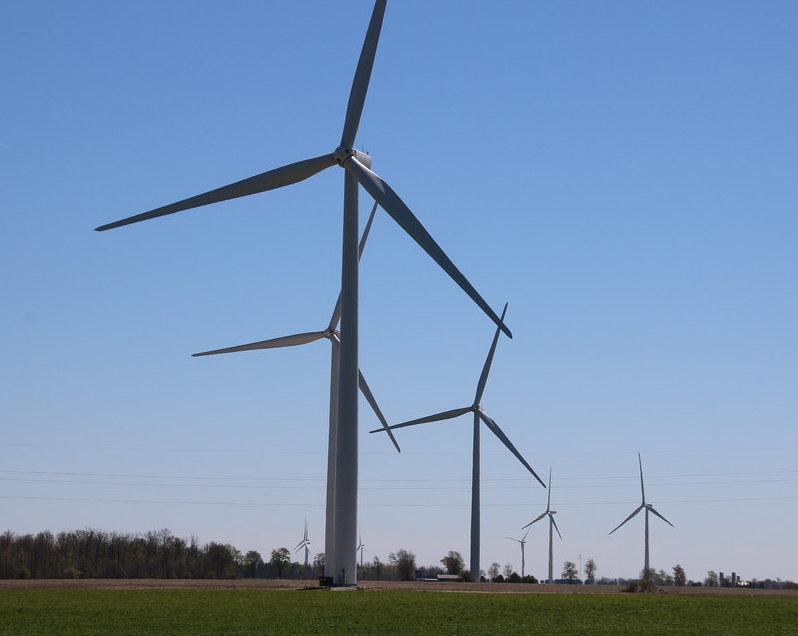 The entire Samsung partnership with
the government included more than $100 million in incentives,
on top of an agreement by the province to buy energy from CS
Wind at above-market rates. It was hailed as an example of the
future of green energy for Ontario and the City of Windsor.
The entire Samsung partnership with
the government included more than $100 million in incentives,
on top of an agreement by the province to buy energy from CS
Wind at above-market rates. It was hailed as an example of the
future of green energy for Ontario and the City of Windsor.
In 2015, the Financial Post reported that "since 2006, when the province first started subsidizing wind turbines, the province has provided more than $1.92 billion in subsidies. This act of corporate welfare is far from over. [...] In total, the amount of subsidies to wind producers could hit $8 billion over the next decade and $13 billion over the next 20 years."
The plant officially closed in 2019, laying off hundreds of workers. CS Wind ended its operations when it did because the Liberal government's Green Energy Investment Agreement was only effective until December 31, 2017 and there were no new agreements in place to continue subsidizing the building of wind towers. Shortly after the Ford government was elected in 2018, it announced it was cancelling 758 wind and solar contracts in the province.
The province's public accounts for 2018-19 show spending of $231 million by the Ministry of Energy on unexplained "other transactions." An NDP researcher uncovered that these "other transactions" were "to fulfil a government commitment to wind down renewable energy contracts." In other words, more public funds to cancel the contracts. Now, the Ford government is telling municipalities that they should ramp up electricity production with new contracts for private providers to serve electric battery makers and the agriculture sector.
Ontario Government Increases Electricity Capacity for Battery Production
The Ontario government is moving swiftly to expand Ontario's
ability to provide electricity in order to meet the demands of
large monopolies like LG, GM, Ford and Volkswagen for electric
battery production as well as for the expanding greenhouse
sector, electrified steelmaking plants and mining operations.
This includes investments in new battery storage for the
electrical grid, new natural gas electricity generation, a new
small modular nuclear reactor and increased use of auctions to
purchase electricity from private industrial and commercial
facilities.
It is of note that although this is all talked about in terms of Ontario, in fact Ontario's electrical grid is fully integrated into a North American electricity grid with most of Ontario electricity exports going to two U.S. states, Michigan and New York.
An article by Allison Jones from CBC notes that Ontario's "energy needs are quickly rising, with the proliferation of electric vehicles and increasing manufacturing demand for electricity on the horizon just as [Pickering,] a large nuclear plant that supplies 14 per cent of Ontario's electricity is set to be retired [in 2025] and other units are being refurbished."
According to Ontario's Independent Electricity System Operator (IESO), "the switch to electric transportation and production processes as well as economic growth in the agricultural greenhouse and electric vehicle manufacturing sectors are increasing Ontario's overall electricity demand."
Ontario Minister of Mines George Pirie said, "Our government is building an integrated supply chain for critical minerals in Ontario as we become a leader in battery manufacturing. Energy system reliability and affordability is essential so that Ontario mines can continue to competitively produce the critical minerals we need for battery manufacturing and other technologies that support the transition to a clean economy."
Todd Smith, Ontario's Energy Minister said, "Our government is building the electricity generation and storage needed to support our success in driving electrification and attracting new jobs to the province, including unprecedented investments, from electric vehicles and battery manufacturing to clean steelmaking."
The IESO notes that "after years of surplus, a capacity gap in the mid-2020s will emerge, translating into capacity and energy needs in the latter half of the decade. These needs will continue through 2040, with demand expected to increase by about 1.7 per cent per year during this period."
Jones reports that Energy Minister Smith has directed the IESO to secure 2,500 megawatts of clean technology such as energy storage along with 1,500 megawatts of new natural gas [electricity generating] capacity between 2025 and 2027. The IESO suggests that both sources of electricity -- natural gas and storage -- can be quickly ramped up and down to meet changes in demand.
At the moment Ontario has only 54 megawatts of energy storage in its electrical grid. In addition the Ontario government through Ontario Power Generation (OPG) has confirmed that it has contracted GE Hitachi Nuclear Energy to deploy a 300 MW Small Modular Nuclear Reactor at the Darlington, Ontario nuclear site.
Besides expanding capacity, the IESO is also relying more on buying electricity from industrial and commercial entities to add short-term capacity. It reports that through the 2020 Capacity Auction they were able to secure 992.1 MW of capacity for summer 2021 from a province-wide auction and will continue to enhance this mechanism to meet short-term demand as "system needs grow."
Justin Rangooni, the executive director of Energy Storage Canada, said that because of the relatively tight timelines, the 2,500 megawatts of storage capacity is likely to be mostly lithium batteries. "Getting that supply for those lithium batteries will be challenging.... It's not a total obstacle, but it will take some time because now ... [you have] not just supply chain constraints, but you're also competing with the U.S., which is really accelerating energy storage adoption," he said.
It appears that in order to provide enough electricity for electric battery manufacturers, Ontario will set up electric battery storage facilities requiring large amounts of lithium and other strategic minerals on top of those that will be used in the batteries made for commercial use which will then be electrified from storage batteries in the grid.
Indicating that electricity storage will be a venue where private interests will seek to make profits, Rupp Carriveau, director of the Environmental Energy Institute at the University of Windsor, said the timing is good. "The space is there, the technology is there, and the willingness among private industry to respond is all there," he said. "I know of a lot of companies that have been rubbing their hands together, looking at this potential to construct storage capacity."
Many commercial and industrial consumers, such as large manufacturing facilities and downtown office buildings, are using storage to manage their electricity usage, relying on battery energy when prices are high. These are the same entities which currently sell capacity to the grid through auctions.
Fraud in Managing Ontario's Electrical System
In June 2018, Canadian Accountant published an article which described rate-regulating accounting. Three of the Big Four accounting firms (KPMG, Deloitte, Ernst&Young and PriceWaterhouseCoopers) were paid at that time by the Ontario government for advice on how to introduce "rate-regulated accounting" to the Independent Electricity System Operator (IESO). This accounting practice is part of the U.S. Generally Accepted Accountability Principles (GAAP). It permits "the recognition of balances arising from rate regulation." The system was used by Enron, the poster child for creative accounting.[2] The underlying idea is that heavily regulated industries, such as public sector utilities and private energy pipeline companies, which are unable to set their own prices, should have a means of deferring costs, such as by building a new power plant. Rate-regulated accounting allows utilities to place such costs in special accounts to carry them forward into future years, provided their regulator (in this case, the Ontario Energy Board) gives them the right to recover those costs through future bills. Such rights can be recorded as assets – even though no electricity has been generated, used or billed for.[3]
One month later, Ontario's then Minister of Finance Charles Sousa, the same one who was elected last December in a federal by-election in the Mississauga-Lakeshore riding for the Trudeau Liberals, announced a balanced provincial budget for 2017-2018. "[A]nd next year and the year after we're projecting it to be balanced, too," he boasted.
Ontario Auditor General Bonnie Lysyk stepped in to ask about the billions of dollars of cost incurred when the hydro rate was cut. As reported in the 2018 Globe and Mail article, Lysyk pointed out: "In order for that [shortfall] to not show up on the bottom line, they created creative accounting to take it off the government's statements." Using that new accounting, the government declared it had balanced the province's books for the fiscal year ending March 31, 2018, just months before a general election. But Lysyk said it was not true. And the Financial Accountability Office (FAO), the body responsible for providing the legislative assembly with independent analysis and advice on Ontario's finances, agreed. In December, the FAO forecast that the province would actually rack up a deficit of $4 billion – a discrepancy that would grow markedly as the government's off-balance-sheet borrowing continues, it pointed out.[4]
What to Expect in the Future?
Lysyk said she was worried that the Wynne government's success in concealing its borrowing would encourage more aggressive bookkeeping, as she called it, both in Ontario and in other provinces.
"If you get away with doing something that's inappropriate accounting, the next time you'll do it again and you'll do it again," she said. "Pretty soon they won't have any numbers that will have any integrity behind them."
Canada's Accounting Standards Board (AcSB) is said to be "an independent body with the authority to establish accounting standards for use by all Canadian entities outside the public sector." Its research reveals a widespread use of U.S. GAAP by hydro utilities in BC, Ontario and Quebec.[5] Professor Michel Magnan of Concordia University and former director of AcSB had a piece of advice to Ontarians about Ontario's public/private power utility. "Follow the money," he said.
In this regard, the Globe and Mail reported that in 2018, KPMG earned between $86,000 and $92,000 in annual fees in the previous three years for auditing the books of Ontario's IESO. In 2017, for its advice on the IESO's new use of rate-regulated accounting, KPMG earned $652,000.
Presently, on IESO's board of directors, sit a Chief Executive Officer and "8-10 additional individuals appointed by the Minister" of Energy of Ontario who also appointed the "first Chief Executive Officer of the IESO. The board of directors appoints subsequent Chief Executive Officers and appoints one of the directors as chair." In examining the biographies of these directors, one finds they have held important posts in big private law firms, the private mining and/or energy sector (e.g., Trans Mountain, Enbridge and the Canadian Gas Association), or in the financial sector (e.g., Merrill Lynch Royal Securities, Nesbitt Thomson and BMO Nesbitt). An example is Joe Oliver who has been in and out of the public/private revolving door as Minister of Finance one day, then chair of IESO's board of directors the next.
One can see that the narrow private interests are oligopolies which have usurped the political power by directly taking over state functions. When it comes to deciding the future of Ontario's power utility, fraud is the name of the game. Anything goes, sanctioned in the name of high ideals. Their promotion of a "green agenda" with the production of lithium rechargeable batteries and electricity storage all in private hands, through pay-the-rich schemes, is sure to end up with the Ontario power utility and the provincial government racking up huge deficits. The workers should intensify pressure to stop the government's use of creative accounting to hide that reality.
Notes
1. "Bad books: How Ontario's new hydro accounting could cost taxpayers billions," Matthew McClearn, Globe and Mail, May 3, 2018
2."What Kathleen Wynne's Hydro fiasco tell us about the accounting profession," Collin Ellis, Canadian Accountant, June 6, 2018.
3. "Bad books: How Ontario's new hydro accounting could cost taxpayers billions," Matthew McClearn, Globe and Mail, May 3, 2018.
4. "Fair Hydro Plan – An Assessment of the Fiscal Impact of the Province's Fair Hydro Plan," Ontario's Financial Accountability Office, Spring 2017.
5. "Rate-regulated Activities – Exploring the decision-usefulness of financial information that reflects the economics of rate-regulated activities," Accounting Standards Board, Research Paper, November 2018.
Information on Electrical Production in Ontario
Ontario is the second largest producer of electricity in
Canada, after Quebec, and has an estimated generating capacity
of 40,200 megawatts (MW). Currently Ontario's high-voltage
grid, controlled by the Independent Electricity System
Operator, has has the following breakdown of capacity:
Nuclear: 13,089 MW (34%)
Gas/Oil: 10,482 MW (28%)
Hydro: 8,868 MW (23%)
Wind: 4,883 MW (13%)
Biofuel: 296 MW (<1%)
Solar: 478 MW (1%)
Ontario's electricity generating capacity is mainly located in southern parts of the province, but there are large hydro generating stations located in eastern Ontario in the Ottawa River Basin and in northeastern Ontario in the Moose River Basin.
Ontario has three nuclear power plants with a combined 12,633 MW of installed capacity that provide the bulk of Ontario's baseload generation. Bruce Power on the east shore of Lake Huron is the largest, with eight generation units and a capacity of about 6,600 MW. It is one of the largest nuclear power plants currently operating in the world.
In 2015, the Ontario government approved refurbishing 10 nuclear generation units – six at the Bruce Power site and four at the Darlington site. This $26 billion 15-year program is one of the largest non-emitting energy projects in North America.
Ontario has over 200 hydroelectricity generation facilities with a total capacity of 9,160 MW.
Ontario has the highest amount of wind generated electricity in Canada which was built between 2005 and 2019.
Ontario had about 97 per cent of Canada's solar capacity in 2019, with 2,670 MW installed.
Ontario has the largest 100 per cent biomass-fueled plant in North America. The 205 MW Atikokan Generating Station was converted from coal in 2014.
Ontario Power Generation (OPG) is the largest utility in Ontario's competitive electricity market, with over 18,600 MW of capacity.
Hydro One owns and operates almost all of Ontario's transmission capacity and has about 30,000 kilometres of transmission lines.
Hydro One is also the largest distributor of electricity in the province, serving nearly 1.4 million predominantly rural customers that represent approximately 26 per cent of the total customers in Ontario. There are over 60 distribution companies operating in Ontario.
Ontario has interconnections with Manitoba, Quebec, Michigan, Minnesota, and New York. Most of Ontario's imports come from Quebec while most of Ontario's exports go to New York and Michigan.
The Ontario Energy Board regulates the energy sector in Ontario, including electricity.
Ontario is now pursuing increases in energy storage in its grid. Energy storage allows for the withdrawal and reinjection of electricity on demand to better optimize the flow of electricity throughout the power system. Currently the Ontario electrical grid has pump storage and flywheel storage.
Pump storage involves using electricity during off-peak periods to pump water into a reservoir and slowly release it to run a turbine and generate electricity when it's needed. Compressed air works similarly, and old salt caverns in Goderich, Ontario are being used to store the compressed air. These caverns currently have a 10+ MWh of storage capacity and a peak power discharge of 1.75 MW.
Flywheels are large spinning tops that can store kinetic energy, which can be used to power a turbine and produce electricity. A flywheel facility in Minto, Ontario has the ability to provide 4 MW of flexibility to the grid, ±2 MW.
Note
1.Provincial and Territorial Energy Profiles – Ontario
Video: Discussion on Ontario's Energy System
Energy production and generation is becoming a very important matter in Ontario as the government pursues a new expansion of the electrical grid as part of its plans to provide the electricity that companies in agriculture, mining and the electric battery sectors are demanding to be profitable. Many decisions are being taken that affect all citizens of the province in this direction which are of concern and it is important that people be able to discuss and be informed about what is happening and decide the direction they want and the direction that serves them.
In this interview, Laura Chesnik interviews Gord Gibbins, Chair of the Alliance to Protect Prince Edward County (APPEC), Janet Wilson, President of Wind Concerns Ontario (WCO) and Margaret Benke, WCO Board Member, about their experiences founding or getting involved with grassroots organizations to work with others to address their concerns with the widespread introduction of government financed industrial wind farm projects in their communities as part of Ontario's Green Energy Act. They also discuss how their experiences with the Green Energy Act has informed their current work to ensure that citizens are informed and have a say in the direction Ontario takes for its energy generation.
NATO
NATO's Drive to Reinvent Itself

Demonstration NATO Summit in Madrid, June 26, 2022.
As it prepares for its Heads of State and Government Summit to be held July 11-12 in Vilnius, Lithuania, NATO released a new strategic concept adopted at its prior summit held in Madrid in 2022 which addresses political priorities. The Atlantic Council, a NATO-linked "think tank" based in Washington DC, has now issued two detailed papers outlining what needs to happen at the Vilnius summit. These latest two documents address military concerns which proved inadequate in the planning and unleashing by NATO of the conflict with Russia, in Ukraine.
One of them is authored by council board member Franklin D. Kramer. Titled, "NATO deterrence and defense: Military priorities for the Vilnius Summit," it looks at how to reinvent NATO -- perhaps in light of the impending failure of its proxy war in Ukraine. It concerns military priorities, command structure, infrastructure, supply chains, weapons production and the like, taking into account military lessons learned from its proxy war in Ukraine, in preparation for continued conflict with Russia and escalating conflict to the point of war with China.
The other is titled "Defining success for NATO's Vilnius summit: A primer," by Charles Barry (visiting fellow at the Institute for National Strategic Studies at the National Defense University in Washington, DC) and Christopher Skaluba (former principal director for European and NATO policy and the principal director for strategy and force development in the Office of the U.S. Secretary of Defense). It is also preoccupied with the proxy war in Ukraine and how to continue to prop up that country to wage war with Russia, as well expanding NATO membership forces and nuclear arms, setting the two per cent of GDP target of military spending by members "as a floor, not a ceiling," and "taking concrete steps to confront the systemic challenge from China."
An op-ed by Hans Petter Midttun, a former Defence Attaché of Norway to Ukraine and Officer (R) of the Norwegian Armed Forces, published in the Kyiv Post, argues in a similar vein that "NATO needs to reinvent itself or risk becoming irrelevant."
Meanwhile, G7 Finance Ministers met on April 12 and Climate, Energy and Environment Ministers met on April 16 and Foreign Ministers met on April 18. Their focus continues to be how to maintain the unity of the G7 despite growing discord on almost everything. While the official line is to intensify sanctions against Russia, recent diplomacy developments and initiatives on the part of several NATO member countries are promoting a peaceful resolution of the Ukrainian conflict. Even states like Brazil are pushing for an end to "Western dominance."
Two-Day Conference of National Armaments Directors
Secretary General Jens Stoltenberg opened a two-day Conference of National Armaments Directors (CNAD) session at NATO Headquarters on April 26-27 to orchestrate the ramp up weapons and ammunition production, to rapidly replenish stockpiles of NATO members and sustain the U.S./NATO proxy war waged in Ukraine. U.S. Deputy Secretary of Defense Kathleen Hicks remarked to Bloomberg press that lessons learned by the US and NATO in the Ukrainian military conflict are preparing for conflict directed against China, the DPRK and others in East Asia. "There are many advantages we've gained for a potential Pacific challenge from the Ukraine conflict," Hicks told Bloomberg in an interview published on April 26. "We're learning now to grow our industrial base and to study that industrial base, which has been for the last 60 years in a bit of a feast and famine cycle," she said. Specifically, Hicks said the U.S. repeatedly used the Presidential Drawdown Authority to speed up the transfer of stockpiles to Ukraine and plans to do the same with Taiwan. "We're thinking about how we use those authorities right now to generate faster and higher-capacity delivery of munitions to provide to our forces in the Pacific," Hicks said, adding that the Pentagon has "a clear strategy that's focused on China."
In related news, the U.S. Air Force is moving its refueling mission from Germany to Poland for the foreseeable future. It is a move aimed at reinforcing NATO's eastern flank, the Air Force said. Nineteen tanker units "based stateside" are slated to go to the west-central Polish town of Powidz, with several planned operations supporting NATO activities. Since the start of the war, the Pentagon has increased the number of U.S. troops in Europe from about 80,000 to more than 100,000. Over 10,000 of those forces are on Polish bases, U.S. ambassador to Poland Mark Brzezinski said in the Air Force statement.
Meeting of U.S.-Led Ukraine Defense Contact Group
U.S. Secretary of Defense Lloyd Austin and Joint Chiefs of Staff Chairman General Mark Milley headed up the U.S.-led Ukraine Defense Contact Group meeting held in Ramstein, Germany on April 21. Some 50 countries attended. Austin emphasized the military hardware sent by the Contact Group to Ukraine to date: 1,550 armored vehicles, 230 tanks, as well as equipment and munitions to support more than 9 new armored brigades. He said that the U.S. has moved up the delivery date for M2 Abrams tanks to sometime this fall, with training of Ukrainian crews to begin in Germany as early as mid-May.
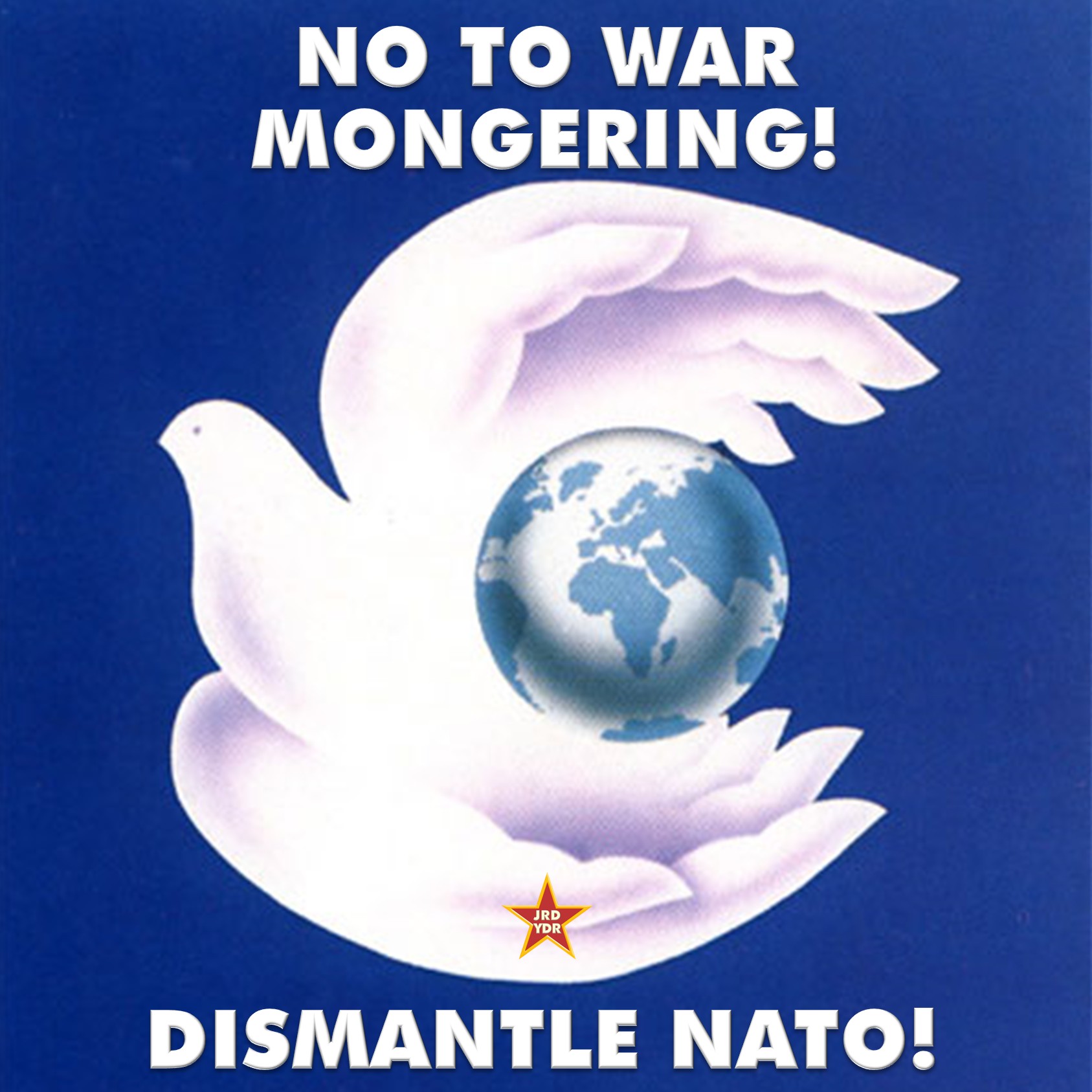 Milley said the U.S. had committed
more than $35 billion in military assistance including over
two million tank and artillery rounds, tens of thousands of
anti-armor weapons, air defence systems (Patriot missile
systems) as well as training of thousands of Ukrainian
forces. Reports highlight the fact that the Defense Contact
Group does not say for example that the Leopard tanks being
sent to Ukraine are a logistical nightmare as each country
supplying tanks has their own firing systems with unique
maintenance requirements and shells manufactured to
different specifications. In answer to questions from media
about providing F-16 fighter jets to Ukraine, Milley and
Austin said that while the decision may yet be made sometime
in future, it was not on the agenda now. They said that "to
take the Ukrainian Air Force from where it is today and to
build it up to match the Russian Air Force" would be "a
significant level of effort by lots of countries." Right now
they said, the immediate need is air defence.
Milley said the U.S. had committed
more than $35 billion in military assistance including over
two million tank and artillery rounds, tens of thousands of
anti-armor weapons, air defence systems (Patriot missile
systems) as well as training of thousands of Ukrainian
forces. Reports highlight the fact that the Defense Contact
Group does not say for example that the Leopard tanks being
sent to Ukraine are a logistical nightmare as each country
supplying tanks has their own firing systems with unique
maintenance requirements and shells manufactured to
different specifications. In answer to questions from media
about providing F-16 fighter jets to Ukraine, Milley and
Austin said that while the decision may yet be made sometime
in future, it was not on the agenda now. They said that "to
take the Ukrainian Air Force from where it is today and to
build it up to match the Russian Air Force" would be "a
significant level of effort by lots of countries." Right now
they said, the immediate need is air defence.
Israeli and Ukrainian officials told U.S. media outlet Axios on April 20 that the Israeli military intends to test its early warning system in the Ukrainian capital of Kiev next month and make it operational for the Ukrainian army by summer.
The Kyiv Independent discusses the prospects of a Ukrainian counteroffensive and while citing NATO confidence that Ukraine can retake some territories currently controlled by Russia, it says the logistics alone of supplying such an offensive with the wherewithal to succeed are beyond Ukraine's capabilities.
NATO Secretary General Jens Stoltenberg said that at the
upcoming NATO Summit meeting in Vilnius, Lithuania in July,
two items on the agenda will be 1) to reaffirm NATO's
support for Ukraine for as long as it takes and 2) that he
expects "NATO Allies to agree a multi-year program to help
Ukraine transition from Soviet-era equipment, standards,
doctrines, to NATO standards and doctrines, and to ensure
full interoperability between Ukrainian forces and NATO
forces."
Following the meeting, Canada's Defence Minister Anita
Anand announced that Canada is providing a "new military aid
package for Ukraine." She announced a $34.6 million
allocation to the North Atlantic Treaty Organization (NATO)
Ukraine Comprehensive Assistance Package (CAP) Trust Fund.
She called it a "donation" which makes it sound charitable.
She said the "donation" will "enable the implementation of
the NATO CAP fuel material project, which will provide
Ukraine with 3.3 million litres of much-needed fuel
supplies; enable the implementation of the NATO CAP Improved
Ribbon Bridge project -- which will provide Ukraine with
modular flotation bridge assets to enable wet-gap crossing;
and provide a first contribution to the NATO CAP medical
first aid kits project." This is all said to be "non-lethal
aid" which creates the impression that it is humanitarian in
nature and diverts from the essential aim which is to
further the aims of the U.S./NATO proxy war in Ukraine which
is the cause of the humanitarian crisis in that country.
Anand also announced approximately $2.5 million for forty
.50 caliber sniper rifles, ammunition and spare parts from
PGW Defence Technologies Inc. The Canadian government has
been sending PGW sniper rifles to Ukraine since at least
2018 in the context of Canada's buildup of troops on
Russia's borders and its training of Ukraine's military to
suppress the dissent of its own people in Donbass and other
areas to the neo-Nazi backed coup government. In 2018 when
the owner of PGW was asked by CBC if he was concerned that
selling weapons to Ukraine would escalate the conflict
there, he said: "It may sound callous, but [I'm] not
particularly [concerned]. Since the dawn of time, mankind
has been engaged in war, and part of that is equipping
yourself properly." Besides contributing to the escalation
of the conflict, these remarks confirm the fraud that these
arms shipments are for defence and supposedly aimed at
responding to Russian aggression, rather than part of
aggression instigated by NATO in Eastern Europe. CBC
reported at that time that the .50 caliber sniper rifle was
the first outcome of the Trudeau government's decision to
start exporting light weapons to Ukraine.
Anand also used the occasion to highlight Canada's
announcement on April 11 that Canada will donate more than
21,000 small arms to the Armed Forces of Ukraine, including
assault rifles, machine guns, and over 2.4 million rounds of
small arms ammunition, sourced from Colt Canada and valued
at approximately $59 million.[1]
In a news release, Anand again spread the disinformation
that "the donations and support" announced by Canada "will
help ensure that Ukraine has what it needs to defend its
sovereignty, independence, and territorial integrity." In
fact, the instigation of the conflict by Canada on its own
and within NATO and its involvement in a U.S./NATO proxy war
being fought "to the last Ukrainian," violates international
law and is a crime against the peace and humanity. The
peoples of Europe are fighting against the anarchy and
violence imposed as a result of the war on their own
countries as well. Canada's support for the neo-Nazis who
were used to carry out the 2014 Maidan Coup in Ukraine and
commit heinous crimes against the Russian-speaking
population in Donbass is already common knowledge and will
be universally condemned in due course. Attempting to seize
victory from the jaws of defeat is a task Canada will not
manage because the cause is unjust and it will continue to
be condemned not only by world public opinion but by all
those who lives have been sacrificed on the altar of
attempts to crush Russia. While the U.S./NATO gangsters and
their representatives in the government of Canada itself are
putting more pressure on Canada to send more money and arms
and put more resources towards continuing the war, the idea
that the issue is whether to send more or less war materiel
to combat Russian aggression is integral to the official
attempt to disinform Canadians so that they cannot find
their bearings and oppose the nefarious role Canada is
playing.
Notes
25th Anniversary of the Good Friday Agreement
British Government's Attempts to Block People of Ireland from Exercising Their Sovereignty

This year marks the 25th anniversary of the Good Friday Agreement concluded on April 10, 1998. The 25th anniversary of the signing is being widely hailed as a watershed in Irish politics. Sinn Féin and the patriotic Irish forces are determined that the current situation must develop into the exercise of sovereignty by the Irish people in a united Ireland while the British continue to treat the north of Ireland as their possession, interfere in Ireland's internal affairs and encourage everything that blocks the exercise of Irish sovereignty.
|
The Good Friday Agreement stipulated the creation of the Northern Ireland Assembly and its Executive. It further set up a north-south council for Ireland, a similar council for London-Dublin, a reduction of British military presence, and a disarmament of the IRA as well as the release of paramilitary prisoners. It became effective as of December 2, 1999.
It followed on from the historic Downing Street Declaration of 1993 at a time Britain was forced to change its policy on northern Ireland as a result of unfolding events both at home and abroad. The Downing Street Declaration reflected Britain's need to be seen as a force for peace in order to gain credibility as a peace-broker abroad, especially in the Middle East. The Declaration was signed by John Major on behalf of the British government and Albert Reynolds on behalf of the government of Ireland. It was the fruit of the struggle of the people to rid the north of the British army and ultimately to end the claim of Britain to possession of any part of the island of Ireland, and to end not only its apparatus of repression and decision-making but also its apparatus for violating the decision-making of the people of Ireland, whether in the north or the 26 counties which currently comprise the Republic of Ireland.
Today, the Irish people's history-making struggle has provided Sinn Féin with overwhelming support to form the government of the north of Ireland but Britain and the political forces at its disposal in the north will not lift their veto on the new arrangements. The crucial step, whether in the context of a united Ireland or the still-existing 26 and six counties, is that Britain end its alleged jurisdiction over any part of Ireland. The Irish people are striving to achieve this by continuing to develop political forms and processes which cement their unity in action and realize their right to self-determination without foreign interference in their internal affairs.
 The peoples of Ireland,
England, Scotland and Wales oppose the misuse of the "peace
process" to exploit the Irish people through other means and
embroil them in British and U.S. imperialist striving for
world hegemony, indicated by British Prime Minister Rishi
Sunak's invitation to U.S. President Joe Biden to celebrate
the anniversary of the Good Friday Agreement in Belfast.
Dismissing the fight of the Irish people for freedom, Biden
credits the U.S. for bringing peace to Ireland. For his
part, Sunak is desperate to claim a win in the deal he has
brokered with the European Union which, he claims, is a
"decisive breakthrough" which ends the crisis caused by the
dispute over the post-Brexit "northern Ireland protocol." He
claimed the changes would the UK to "take back control" by
providing "stability in Northern Ireland." "It's about
showing that our union that has lasted for centuries can and
will endure," he said.
The peoples of Ireland,
England, Scotland and Wales oppose the misuse of the "peace
process" to exploit the Irish people through other means and
embroil them in British and U.S. imperialist striving for
world hegemony, indicated by British Prime Minister Rishi
Sunak's invitation to U.S. President Joe Biden to celebrate
the anniversary of the Good Friday Agreement in Belfast.
Dismissing the fight of the Irish people for freedom, Biden
credits the U.S. for bringing peace to Ireland. For his
part, Sunak is desperate to claim a win in the deal he has
brokered with the European Union which, he claims, is a
"decisive breakthrough" which ends the crisis caused by the
dispute over the post-Brexit "northern Ireland protocol." He
claimed the changes would the UK to "take back control" by
providing "stability in Northern Ireland." "It's about
showing that our union that has lasted for centuries can and
will endure," he said.
Britain should stop interfering in the affairs of the Irish people. How they want to proceed is up to them, nobody else. The progressive forces in Ireland demand as a principle that there must be no interference by the British government or the U.S. administration in the internal affairs of Ireland.
This principle was enshrined in the Downing Street Declaration which guided the Good Friday Agreement. It said: "The British government agree that it is for the people of the Island of Ireland alone, by agreement between the two parts respectively, to exercise their right of self-determination on the basis of consent, freely and concurrently given, North and South, to bring about a united Ireland, if that is their wish." Despite this, Sunak is talking about "a union that has lasted for centuries and will endure," and the Northern Ireland Assembly, set up by the Good Friday Agreement, has been tainted since the beginning by British dictate, in particular the division into "two communities."
It is the persistence of the British government that the six northern counties must remain part of the United Kingdom which is causing the Northern Ireland Assembly to be dysfunctional. The British government has no right to interfere in the functioning of the Northern Ireland Assembly. This is a fundamental principle. The Irish people are striving to find a way forward both in the north and the south which favours the people. So too, the opinions of the entire Irish people who inhabit the island of Ireland are crucial for a permanent solution of the issue of Irish reunification.
The heroism of the Irish people in resisting the domination of their country by armed might of the British empire is legendary. Since the Downing Street Declaration in 1993, and particularly since the voluntary conclusion of the armed struggle in 1998, the people of Ireland themselves are involved in sorting out their own decision-making and it is up to them to decide their own future. The English working class is duty-bound to prevent the British government from interfering in Ireland's internal affairs and oppose all its attempts to set the agenda.
As it did during the years of struggle in Ireland for Irish Freedom against British occupation, impunity and cruelty, so too today, the working class in England, Scotland and Wales stand as one with the Irish people as the makers of history. Theirs is a common cause to oppose and block the usurpation of their decision-making power by international finance capital and the narrow private interests which operate as cartels and coalitions of oligopolies which includes the United States/NATO configuration.
To their credit, Sinn Féin's MPs elected to the Westminster Parliament have consistently refused to take their seats, because they refuse to pledge allegiance to the English monarch. This shows that the peaceful reunification of Ireland is on the agenda on the basis of building the Irish nation anew. The patriotism, internationalism, creativity, initiative and death-defying courage with which the Irish people have faced the cruelty of the British monarchy which invaded and occupied Ireland in the past and of British imperialism in the twentieth century is indeed legendary. They are now proving themselves once again as they strive to engage all Irish people at home and abroad in a nation-building project which favours them and permits the emergence of a modern democratic personality in the form of a united Irish state which upholds the rights of all without exception.
Cuba
Cuban People Give Strong
Vote of Confidence
to Their Revolution
Through their participation and the results they delivered in the March 26 parliamentary election the Cuban people made a strong statement in support of their Revolution, its leadership and Cuba's democracy. In a fitting rebuke to the U.S.-inspired smear campaign of Cuba's People's Power and push for citizens to abstain from voting, 76 per cent of registered voters turned out to elect the 470 deputies who will hold seats in the National Assembly of People's Power for the next five years.
Of the ballots cast, 90.3 per cent represented valid votes; 6.2 per cent were blank and 3.5 per cent were spoiled. Every one of the newly elected and re-elected deputies obtained over 61 per cent of the valid votes in their respective electoral districts, making it unnecessary to hold any second round votes or seek new candidates – a statement in itself. Among those elected or re-elected were the First Secretary of the Communist Party and President of Cuba, Miguel Díaz-Canel, Vice-President Salvador Valdés and Prime Minister Manuel Marrero and the country's Past President and historic leader of the Revolution, Raúl Castro along with many other recognized leaders and well known personalities in different fields of endeavour as well as workers from a cross-section of the economy and students.
|
Women now hold 55.3 per cent of the seats in the new parliament, second only to Rwanda in that regard. The average age of deputies is 46, with 20 per cent being 35 years old or younger. Forty-five per cent are of African descent and 64 per cent are first-time deputies.
Voting in Cuba is voluntary, with citizens 16 years of age and up who have been resident in Cuba the last two years eligible to vote. On election day voters were able to cast their ballots at any of 23,648 voting stations around the island, which included 250 special polls held in hospitals, hotels, campgrounds and other places where a need was identified.
Voters were presented with a ballot containing the names of candidates nominated in their municipality or electoral district. For example, in Villa Clara there were eight candidates, one of whom was President Miguel Díaz-Canel. The candidates have all gone through a rigorous multi-stage candidate selection process in which it is the people themselves, the mass organizations to which 90 per cent of Cubans belong, and the recently elected delegates to the country's 169 Municipal Assemblies -- not the Communist Party of Cuba or any political party -- who have proposed and nominated them. In Cuba's parliamentary elections, people have the option of voting for all of the candidates on their ballot, just for some of them, one, or none. In this election, 72.1 per cent of electors voted for all of the candidates on their ballot while 27.9 per cent voted selectively for only some candidates.
|
The vote for all candidates on the slate was a response to the call for a united vote in the face of the very difficult circumstances the Cuban people are experiencing as a result of the siege the country has been put under by the U.S. It was a vote cast in the spirit of Fidel's speech in 1993, during the Special Period, calling on Cubans at that time to defend the Revolution, its values and many achievements by sending a clear message to the enemy of "our unity, of our strength, our determination." That is what the majority of Cubans did on March 26.
Elaborating on the rationale for a united vote, President Díaz-Canel explained at a meeting of candidates with residents of Villa Clara that it is recommended so that all candidates, whether they are more or less known to the people, are on equal terms, given that they all have enormous merits even though some are less known than others. Rather than choosing among several candidates to elect just one, Cuba's system aims to have all those confirmed through the multi-stage nomination process elected, so everyone is represented, he said.
It is a revolutionary strategy, he said, but not an imposition. Those who understand the reason for the united vote, vote for everyone on the list; those who do not, vote selectively. The important thing, he emphasized, is enabling all candidates to be elected so that no one is diminished or at a disadvantage because they are more or less known.
Taking place as it did when U.S. aggression aimed at turning the Cuban people against their revolution and its leadership is at an all time high, the turnout and results of the election represented a strong vote of confidence in the Revolution and its leadership and a clear repudiation of the efforts of counterrevolutionary elements and their U.S. instigators to convince people not to exercise their right to vote.
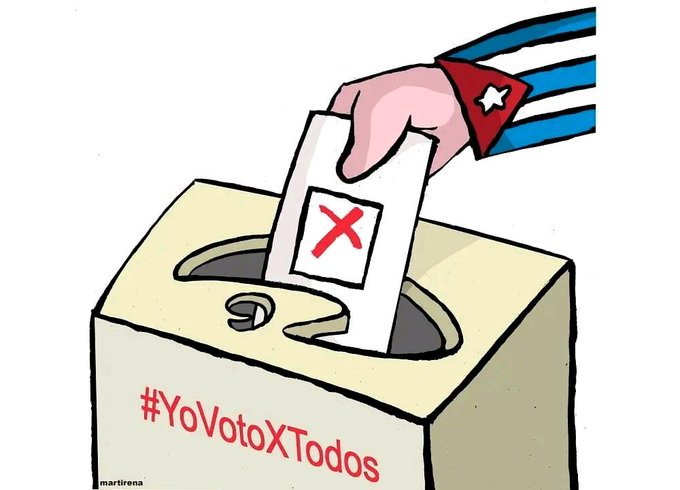 The pressure to abstain took
different forms. One involved incessantly presenting the
effects of the suffocating U.S. blockade and campaign of
applying "maximum pressure" on Cuba -- meaning on the Cuban
people -- as being the fault of the Cuban government. It
also included the circulation of false rumours such as that
anyone who voted in the election would not be able to apply
for admission to the U.S. through the "humanitarian parole"
avenue which allows Cubans otherwise inadmissible or
ineligible for admission to the U.S. to be admitted on a
temporary basis for "urgent humanitarian reasons." On
election day, counterrevolutionary "influencers" took to
social media to spread lies about Cubans staying away from
voting centres in droves, when in fact just two hours after
the polls opened, almost 1.5 million Cubans -- 18 per cent
of the total electoral roll -- had already voted.
The pressure to abstain took
different forms. One involved incessantly presenting the
effects of the suffocating U.S. blockade and campaign of
applying "maximum pressure" on Cuba -- meaning on the Cuban
people -- as being the fault of the Cuban government. It
also included the circulation of false rumours such as that
anyone who voted in the election would not be able to apply
for admission to the U.S. through the "humanitarian parole"
avenue which allows Cubans otherwise inadmissible or
ineligible for admission to the U.S. to be admitted on a
temporary basis for "urgent humanitarian reasons." On
election day, counterrevolutionary "influencers" took to
social media to spread lies about Cubans staying away from
voting centres in droves, when in fact just two hours after
the polls opened, almost 1.5 million Cubans -- 18 per cent
of the total electoral roll -- had already voted.
The U.S. has also been causing trouble by encouraging the irregular and often dangerous emigration of Cubans, recently going so far as to grant asylum to a person who hijacked and flew a plane to the U.S. from Cuba in violation of formal agreements between the two countries as well as Cuban law, international law and civil aeronautics regulations.


When the preliminary results were announced on the morning of March 27 by the National Electoral Council, President Díaz-Canel greeted them by saying that in spite of all the draconian measures the U.S. resorted to, "Cuba Won!" He also said there was only one way to respond to the vote, which he called extraordinary in the current conditions of the nation and the world: fulfil our commitments to the people.
Miguel Díaz-Canel Re-Elected President of Cuba at Opening
Session
of New Parliament

On April 19, one of the most significant dates in the history of revolutionary Cuba, marking the anniversary of the defeat in 1961 of the U.S. invasion forces at Playa Giron, the 10th Legislature of the National Assembly of People's Power held its constitutive session. As their first act after taking the oath of office, the deputies elected the president, vice president, and secretary of the National Assembly and other members of its Council of State, as well as the president and vice president of the Republic from among their own ranks. They did so following a rigorous process analogous to the one by which they themselves were proposed, nominated and elected.
To establish the candidacies for these leadership positions, members of the National Candidacy Commission met personally with deputies around the country elected on March 26 and received their individual written proposals for candidates. After consideration of all the proposals, on April 19 the Commission presented deputies with the names and biographies of candidates they recommended for the positions to be elected. The candidacies were all approved through a show of hands, following which deputies voted in a secret ballot where they could accept or reject each candidate or abstain from voting. Esteban Lazo was re-elected as president of the National Assembly and Council of State and Ana Mari Machado as vice president through this process .
The same process led to the candidates for president and vice president of the Republic being approved and then elected, with a number of deputies rising to speak before balloting took place about why those nominated merited election. The process culminated with the re-election of Miguel Díaz-Canel as president with an overwhelming vote of confidence of 97.66 per cent, and of Salvador Valdés as vice president with a vote of 93.4 per cent. Finally, on the recommendation of President Díaz-Canel, deputies appointed the country's prime minister (Manuel Marrero), deputy prime ministers, secretary and other members of the Council of Ministers.
Congratulations to the Cuban people for the decisive victory they have achieved in these elections by giving a strong vote of confidence to their Revolution, their revolutionary leadership and the democratic processes they have provided themselves with to defend and continue perfecting their People's Power.
(Prensa Latina, Granma. Photos: Presidencia Cuba, ACN, Cubadebate, Venceremos)
Lively Discussion on Elections in Cuba
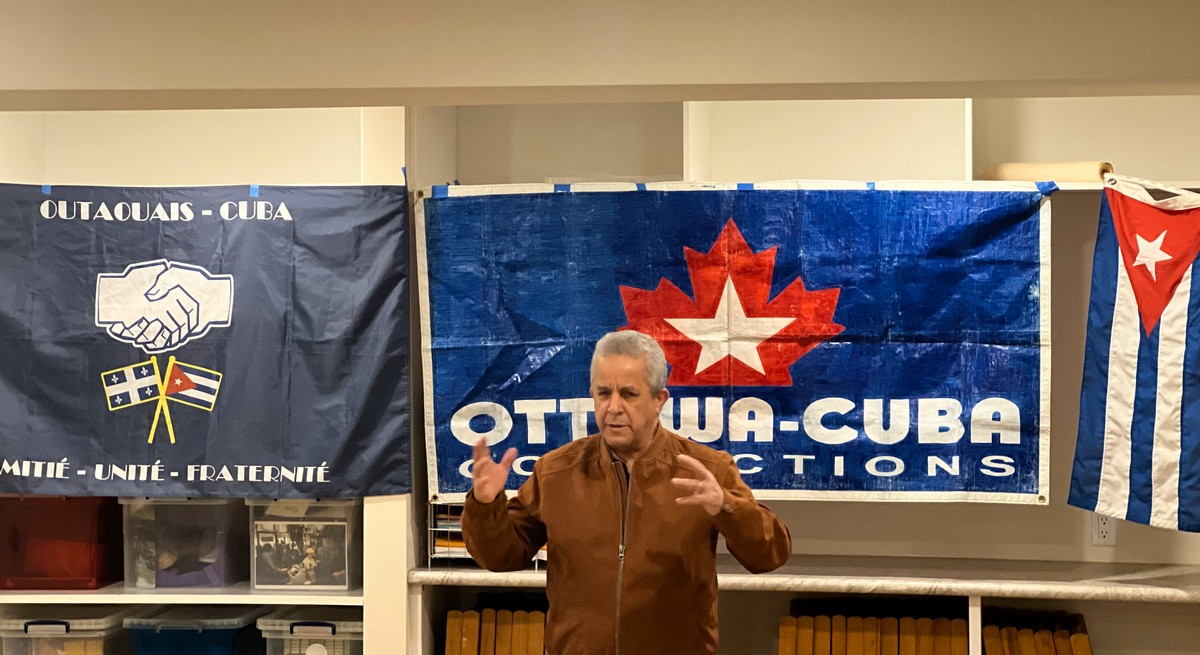
On the evening of March 17, His Excellency Hector Igarza Cabrera, Cuba's Ambassador to Canada, spoke to friends of Cuba in the Ottawa-Gatineau region about the upcoming national elections in Cuba.
The Ambassador explained that elections for the National Assembly take place every five years as part of the democratic process in Cuba. The Communist Party of Cuba does not nominate candidates; that role belongs to electors and various collectives of the people so that all sectors of the economy and society are represented. These include the Cuban Workers' Central and the Federation of Cuban Women, organizations of the youth, agricultural workers and others. Cuba has the highest percentage of women delegates at 55.3 per cent of its National Assembly, second only to Rwanda in terms of the number of women in office.
The Ambassador pointed out that this year's elections are taking place in a context of an extremely difficult economic situation, with shortages of food, medicine and electricity. On top of this, a U.S.-backed campaign of total interference in Cuba's electoral process is taking place on social media calling on the Cuban people to either not vote or to spoil their ballot. These combined factors may play a role in reducing the number of votes cast, he said, at least to some extent. At the same time, the participation of the Cuban people in the political process is extraordinarily vibrant and broad, he said. It even includes the children who are mobilized to oversee the ballot boxes and ensure that all voting is done according to the requirements of the electoral law. The participation of people from all walks of life in nominating candidates, voting for them and supervising them after they are elected is proof of the confidence the people have in their own government.
The Ambassador explained that unlike elections in the U.S., for example, in Cuba there is no campaigning as far as the candidates are concerned. Rather than having endless campaign meetings and advertising where candidates try to outdo one another in terms of lies and false promises, in Cuba candidates simply fill out a one-page curriculum vitae. When asked what quality Cubans look for when choosing a candidate, the Ambassador immediately answered that the people expect their elected representatives to serve their community. That is the criteria.

Ambassador Igarza insisted that the biggest obstacle at this time in terms of meeting the basic needs of the people in Cuba is the blockade. He said that the minute a product on the market contains 10 per cent of U.S. components, it cannot be sold to Cuba. He spoke of a contract worth $4.7 million with a pharmaceutical company in Canada for the purchase of antibiotics and products for the treatment of cancer. The company was bought by U.S. interests and the contract was ended. The importation of oil to Cuba is also sanctioned, leading to blackouts and problems in transportation. A positive aspect in terms of relations with Canada, the Ambassador pointed out, is that 52 per cent of tourists in Cuba are Canadian. As well, because of the Canadian Foreign Extraterritorial Measures Act (FEMA), Canadian businesses can circumvent U.S.-imposed restrictions on trade with Cuba.
Following the meeting a call was adopted to use the occasion of the visit to Ottawa of U.S. President Joe Biden on March 23 to protest the U.S. blockade of Cuba and demand it be ended. It was considered that Biden would most likely claim to be a great defender of human rights, even as the blockade is an open attack on the human rights of the Cuban people and it is making life extremely hard for the ordinary people. These sanctions are aggravated by the fact that the U.S. has put Cuba on a spurious list of so-called State Sponsors of Terrorism, which makes it even more difficult for Cuba to undertake business and commercial transactions with other nations, depriving the Cuban people of basic necessities for their health and well-being.
In total violation of the right of peoples to self-determination and the international rule of law, as well as through open interference in the life of Cuban people, the U.S. continues to try to fan the flames of discontent. This is done with the avowed aim of making the Cuban people suffer, in hopes that this will lead to regime change. It is a failed policy which for 60 years has not incited the Cuban people to rise up against the revolution which is the guarantee of their sovereignty.
Some Distinguishing
Features of
Cuba's Electoral System
A major distinguishing feature of Cuba's electoral system is how candidate selection takes place and the importance it is given. Candidates are not chosen by a political party as is the case in so many countries that claim to be democratic but have virtually eliminated any role for the people other than voting for candidates they had no part in selecting and perhaps serving as foot soldiers to distribute campaign materials prepared by a marketing firm to "sell" a given party's candidate to electors who have been micro-targeted.
Candidate Selection
In Cuba candidates are selected through a rigorous, inclusive process starting at the grassroots level, with proposals for pre-candidates put forward in plenary sessions of the mass and student organizations to which 90 per cent of Cubans belong -- the Cuban Workers' Federation, Cuban Women's Federation, the Federations of University Students and of Middle Level Education Students, the National Association of Small Farmers and neighbourhood Committees in Defence of the Revolution. Members of these organizations are not restricted to proposing only people from their own organizations.
The proposals received (in this election there were over 19,000) then pass to candidacy commissions, made up of representatives of the aforementioned organizations and headed by the Cuban Workers' Federation. The commissions in each municipality analyze the biographies of the proposed candidates and prepare their own draft proposals from among the names they have received after reviewing and deliberating on them one by one, coming up with a smaller pool of pre-candidates (just over 4,100 in this election). Eventually, a slate of pre-candidates corresponding to the number of deputies to be elected in each electoral district, is presented to the delegates in each of the country's 169 Municipal Assemblies of People's Power for their consideration and approval (or rejection) through votes taken on each of the pre-candidates. New pre-candidates are proposed to them by the candidacy commissions for any that are rejected. Nationwide, this involves some 12,000 municipal delegates, all recently elected themselves, confirming the nomination of 470 people to fill the same number of seats in the National Assembly. The electoral law adopted in 2019 calls for there to be one deputy for every 30,000 inhabitants or fraction greater than 15,000. Those nominated are expected, as a group, to reflect as closely as possible the current diverse makeup of Cuban society. Electors have the option of voting for all candidates named on the ballot for their electoral district, for some of them, or just one. To be elected, candidates must receive over 50 per cent of the votes cast by their constituents in a secret ballot.
 In explaining how candidate
selection takes place in Cuba, Consuelo Baeza Martín,
president of the National Candidacy Commission said the fact
that the candidacy commissions are made up of mass
organizations that are part of Cuban civil society
strengthens a cardinal requirement of the Cuban political
system, which is that the people freely and democratically
propose and nominate their candidates, rather than that
being the prerogative of a political party. It also ensures
that candidates are ordinary people with demonstrated
qualities, skills and ethics that make them suitable to
carry out the responsibilities of the office of deputy in
the country's highest legislative body, rather than
primarily people of economic means or who are connected to
the private interests that operate through political parties
and the governments they form in countries like the U.S. and
Canada that rail about the supposed lack of democracy in
Cuba.
In explaining how candidate
selection takes place in Cuba, Consuelo Baeza Martín,
president of the National Candidacy Commission said the fact
that the candidacy commissions are made up of mass
organizations that are part of Cuban civil society
strengthens a cardinal requirement of the Cuban political
system, which is that the people freely and democratically
propose and nominate their candidates, rather than that
being the prerogative of a political party. It also ensures
that candidates are ordinary people with demonstrated
qualities, skills and ethics that make them suitable to
carry out the responsibilities of the office of deputy in
the country's highest legislative body, rather than
primarily people of economic means or who are connected to
the private interests that operate through political parties
and the governments they form in countries like the U.S. and
Canada that rail about the supposed lack of democracy in
Cuba.
During one of the meetings held with people from different social sectors by the eight candidates for deputies for the municipality of Santa Clara, of which he was one, President Miguel Díaz-Canel addressed the allegations of Cuba's detractors, saying that in Cuba, deputies are submitted six times to popular decision processes. "Does that happen in the United States or in any of the other countries that want to impose their democracies on us?" he asked.
No Campaigning, Election Promises, or Use of Money to Buy Votes
Another distinguishing feature of Cuba's system is that there is no campaigning for or against any candidates, or making of "election promises" by candidates. Electoral authorities must also ensure that no assets or means belonging to any candidates, their close relatives or others, that compromise their impartiality, or give rise to disagreements and discord among voters, are used in elections.
Provisions for an Informed Vote
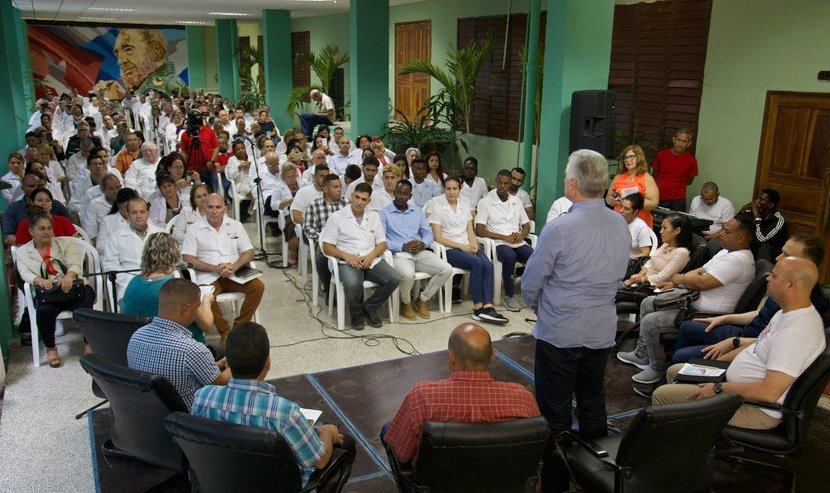 After being confirmed, the eight
candidates for Villa Clara engage in discussion with local
representatives of mass organizations, February 6, 2023
After being confirmed, the eight
candidates for Villa Clara engage in discussion with local
representatives of mass organizations, February 6, 2023
In order for electors to cast an informed vote they are provided well in advance of election day with the following information together with a photograph of each candidate: their name, date of birth, sex, marital status, highest grade of schooling or post-secondary education completed, professional or trade qualifications, current occupation, place of residence, organizations they belong to, and a short description of their personal qualities and capacity that demonstrate why they are qualified to fulfil the responsibilities of a deputy. The information is prominently posted in public places as well as online. Candidates themselves meet with workers in different sectors, students and others in their constituencies to listen to their concerns and expectations and engage in discussion with them, but not to compete with one another for votes.
Once elected, deputies are not paid for performing their duties but continue receiving whatever salary they normally get for the jobs they do if they are employed. To fulfill their responsibilities, they are obliged to maintain close ties with the people, listen to their opinions, suggestions and concerns as well as to increase their own knowledge in various fields and to keep themselves informed about national and foreign events, and importantly, render accounts periodically to their constituents. The same applies to those in the highest positions of leadership, including the president, vice president and prime minister of the republic. Under Cuba's electoral law all are subject to recall before their term expires, if the circumstances warrant it.
Deputies Elect Leadership of National Assembly and of the
Republic
from Among Their Peers
A rigorous process similar to the one followed for selecting candidates for deputy is set out for the nomination of candidates for the leadership of the National Assembly and of the Republic -- all of whom must be elected by their peers in the new parliament. In this election, from April 3-9, members of the National Candidacy Commission travelled throughout Cuba consulting those elected on March 26 to obtain their written proposals for deputies they would nominate to serve as president and in other leadership positions of the National Assembly, the 21-member Council of State and for president and vice president of Cuba. To be elected to any of these positions deputies must receive over 50 per cent of the vote of their peers in a secret ballot.
(Cubadebate. Photos: Cubadebate, Presidencia Cuba)
Ninth Container of Medical
Aid Sent to Cuba
by Cuban Canadians
The Juan Gualberto Gómez Association of Cubans resident in Toronto has just dispatched its ninth container full of medical supplies to Cuba. In a video message filmed on April 10 right after volunteers finished loading the supplies they had gathered into a container, the Association's president Julio Fonseca explained that the shipment was their contribution to the "World Tsunami against the Blockade," an initiative launched earlier in the week by the "Europe for Cuba" platform.
 The "Tsunami" is aimed at
mobilizing groups, personalities and individuals to be part
of a wave of actions going from country to country and from
one continent to another against the U.S. economic,
commercial and financial blockade of Cuba, with groups
called on to organize actions of different types for this
purpose during April and May. Two other organizations, Not
Just Tourists - Toronto and the Canadian Cuban Friendship
Association Toronto, collaborated with the Juan Gualberto
Gómez Association to fill the container which is destined
for the Cuban province of Pinar del Rio. Previous shipments
organized by Cubans living in Toronto have gone to different
parts of the country to help Cuba deal with the pandemic as
well as natural disasters and the two deadly accidents
suffered last year -- the collapse of the Saratoga hotel in
Havana and the oil fire in Matanzas.
The "Tsunami" is aimed at
mobilizing groups, personalities and individuals to be part
of a wave of actions going from country to country and from
one continent to another against the U.S. economic,
commercial and financial blockade of Cuba, with groups
called on to organize actions of different types for this
purpose during April and May. Two other organizations, Not
Just Tourists - Toronto and the Canadian Cuban Friendship
Association Toronto, collaborated with the Juan Gualberto
Gómez Association to fill the container which is destined
for the Cuban province of Pinar del Rio. Previous shipments
organized by Cubans living in Toronto have gone to different
parts of the country to help Cuba deal with the pandemic as
well as natural disasters and the two deadly accidents
suffered last year -- the collapse of the Saratoga hotel in
Havana and the oil fire in Matanzas.
Fonseca emphasizes that the blockade is an economic war that the U.S. has declared on the people of Cuba, and is the primary cause of the country's problems today. In a video message he sent registering the Juan Gualberto Gómez Association's support for the World Tsunami Against the Blockade, he demanded that the U.S. government cease its attempt to suffocate Cuban families and remove Cuba from its list of countries that supposedly sponsor terrorism. They know very well where terrorism comes from, and Cuba's position on it, he said.
(Photos: J. Fonseca, Cuban Consulate)
India
Farmers and Workers Remain
Undeterred
Despite Show of Force

On April 5, more than 100,000 farmers and workers from across India travelled to the capital New Delhi to protest the central government and its anti-farmer and anti-labour policies. The rally, under the banner Mazdoor Kisan Sangharsh (Worker-Peasant Struggle), was held at the Ramlila Maidan grounds.
Protesters demanded relief from inflation, a legal guarantee of the Minimum Support Price (MSP) on main crops, a minimum wage for all workers of Rs 26,000 (U.S.$317) per month, debt relief, a pension for all farmers over the age of 60, repeal of the four anti-labour codes, and withdrawal of the Electricity Amendment Bill 2020, among other demands. Protesters accused the Narendra Modi-led government of creating a crisis of livelihood for all sections of the working class.
Thousands of people continue to gather at morchas in Mohali, Bargari, Mudaki and other places to call for the release of political prisoners, the resolution of the water crisis, a guaranteed MSP, the withdrawal of the electricity bill, etc.
Farmers are going from village to village to hold meetings in preparation for the April 30 rally in Delhi, to highlight their calls and galvanize their ranks. They explain to people their long-term demands: Faslon Ke Faisle Kisan Karega (Farmers Will Decide About Their Produce); Fasal Ate Nasal (Fight for Crops and the Next Generations); Sarbat Da Bhala (For the Well-Being of All); Pavan Guru, Pani Pita, Mata Dharat Mahat (Save Air, Water and Land from Pollution).
Many news channels were closed in Punjab and journalists arrested, and time off for police personnel cancelled ahead of mass gatherings April 13, the occasion of Baisakhi, the spring festivals, and the founding of the Khalsa. Eighteen battalions of central paramilitary forces were also deployed. But the show of force did not scare or deter people. They continued organizing in villages, towns and cities, their spirits high.
A Farmer-Worker Mahapanchayat was organized at Marra, a village in Patan Tehsil of Durg District, Chhattisgarh on April 7. Thousands of people gathered. Speakers addressed the problems of farmers in the panchayat and delivered a memorandum to the concerned authorities.
State-sanctioned communal violence is happening in Bihar and other places. According to news reports, at least four districts in Bihar witnessed communal violence on the occasion of Ram Navami this year, with Bihar Sharif in Nalanda, the home district of chief minister Nitish Kumar, seeing the worst of it. In Bihar Sharif, about 70 kilometres from Patna, not only were more than a dozen shops and godowns set ablaze, but the more than 100-year-old Madrasa Azizia, with its library of 4,500 books, was also burned. Stones were pelted at a mosque adjacent to it right under the watchful eyes of the police and other officials.
The Indian ruling elite and government are following the standard operating procedures introduced by the British before independence. A broad attack on the rights of the people is underway on this or that pretext. Those who are claiming that "this is not democracy" are laying claims to the kind of democracy they want to bring into being.
(To access articles individually click on the black headline.)
Website: www.cpcml.ca Email: editor@cpcml.ca


 Sinn Féin protesters
greet the Queen's visit to northern Ireland in 1977.
Sinn Féin protesters
greet the Queen's visit to northern Ireland in 1977.




